

Copyright 1925 by
W. H. Murray
GENERAL PASSENGER AGENT
Union Pacific System
OMAHA, NEB.
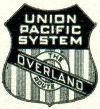
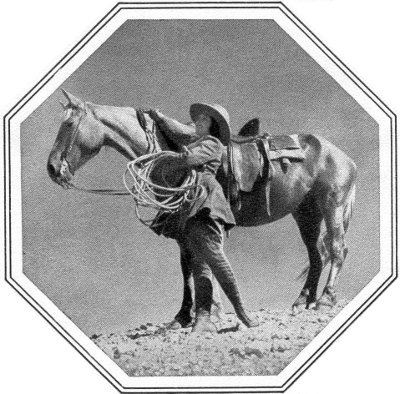
ISSUED BY THE
Union Pacific System
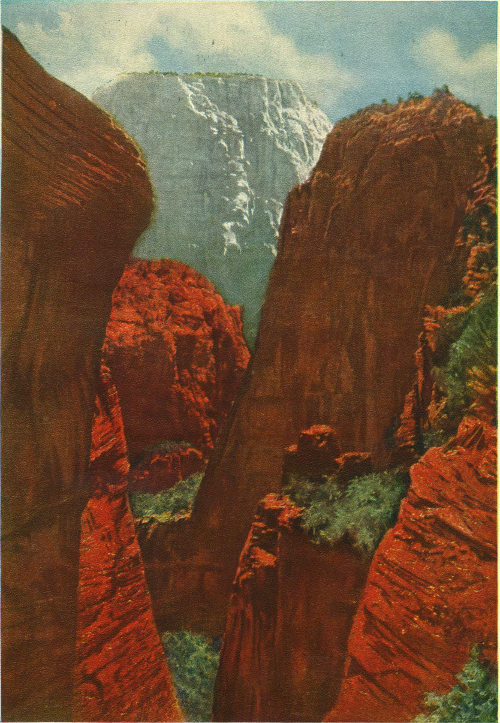
The Great White Throne from West Rim Trail, Zion National Park
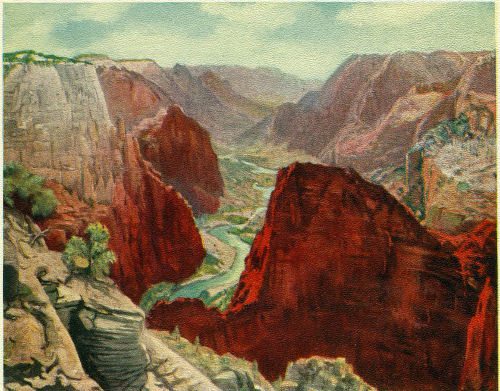
Panorama of Zion Canyon
Touched by a light that hath no name,
A glory never sung,
Aloft on sky and mountain wall,
Are God’s great pictures hung.
—Whittier
Southward from the thirty-eighth parallel of latitude the surface of Western Utah descends in magnificent “Cyclopean steps” from the flattened summits of the Wasatch Mountains, 11,000 feet high, to 3,000 feet at the Rio Virgen, then ascends gently in Arizona to the colossal arch of the Kaibab Plateau, 9,000 feet in elevation and overlooking the Grand Canyon. These Titanic terraces and palisaded plateaus, more particularly the flaming canyons and jeweled amphitheatres cut from their color-saturated rock layers, form scenic spectacles without peer or rival on the globe. Nothing else is comparable to these wonderlands. To see them is both a thrilling adventure and an artistic delight.
Measured by civilization’s yardstick, the unknown land in which they lie is a frontier, still in the pioneer stage of existence. It is not so long since the forts along the way actually repelled Indian attacks; it is not so far to fastnesses where cougars come forth to prey on deer, or to desert valleys where wild mustangs range. On the edge of the plains are ruins of primitive dwellings of which the modern Indian knows nothing; in many a secluded canyon are the more inscrutable habitations of the 6 cliff dwellers. The indomitable ranchers have built quaint, poplar-shaded villages with homes of adobe, and their farms are often fenced with stone.
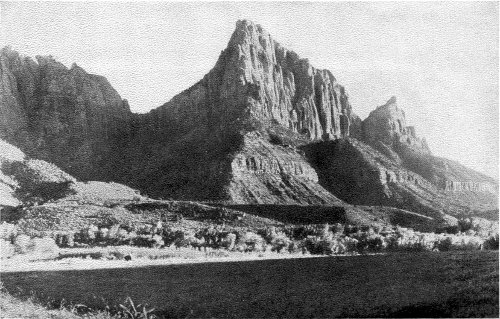
The Watchman, Zion National Park
It is a mysterious land of purple sage and empurpled distances, of incredible color, of sun-magic and the wizardry of wind and water. It is a place to drink in beauty, to form new conceptions of the divine.
Geologists recognize three subdivisions of the region from north to south: the High Plateaus; the Terraced Plateaus; the Grand Canyon Platform. From Cedar Breaks on the High Plateau it is more than 100 miles to Bright Angel Point on Grand Canyon’s rim; from Hurricane Ledge on the west, eastward to the Colorado River is more than 100 miles.
The country reveals fascinating chapters of geologic history. It is a region that has undergone great transitions, alternately sea bottom and mountain top; a region broken and tilted by tremendous displacements; a region scorched and branded by intense volcanic action; but more than all else, from the viewpoint of human interest, a region profoundly sculptured and given its most distinctive character by the beauty-creating genius of erosion.
From Cedar Breaks, cut into mountains 11,000 feet high, the vision has a sweep of 100 miles, and the vast terraces may be seen thrust out to the south like promontories into the sea. Where one succeeds another, the uppermost presents sinuous cliff walls, hundreds of miles in length and superbly distinctive in color and carving. More than 10,000 feet of strata are exposed, “a library of the ages in vivid bindings” that contains the fossil remains of creatures since the morning of life on earth. Each step down indicates the removal, by streams, rain, frost and wind, of all the rock-layers above it. From the Grand Canyon Platform, these 10,000 feet of strata have been completely swept away.[1]
The highest of the Terraced Plateaus, the Markagunt and Paunsaugunt, in which Cedar Breaks and Bryce Canyon lie, break down in spired palisades of the Pink Cliffs, endless in sculptured variety. Beneath the Markagunt the southern scarps of the Kolob Plateau, into which flaming Zion Canyon is sunk, form noble cliffs of pure, reposeful white. The next step downward displays the glowing Vermilion Cliffs, castellated with ornate prodigality and perhaps the grandest of all. Lower still are the Shinarump Cliffs, banded with reds, 7 browns, yellows, greens and purples. Between them and the Kaibab lies a stretch of desert like a flattened rainbow. Such is the strange, magnificent and colorful structure of the land.
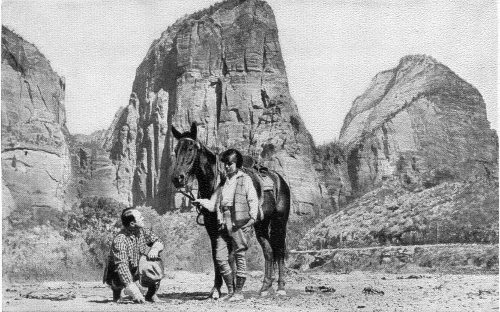
Angels Landing, Zion National Park
Zion Canyon is a profound gorge with the colors of blood, fire and snow, a matchless carving by the greatest of all sculptors, erosion. Several of its mighty rock temples rank with the most majestic masses in the land. The variety of its endless etchings, the exquisite harmonies of its painted precipices, the sustained grandeur of its stupendous buttes and walls, its glorious cycle of color from dawn to sunset are sources of undimmed delight to the artistic instinct within everyone. It has one aspect of beauty from its green-garbed floor, another from its dizzy rim of white; from the dusky depths of the Narrows the dominant sensation is soul-gripping awe.
Zion National Park includes other canyons of extraordinary interest, and the entire terrace-top of the broad Kolob Plateau is a domain of incredibly fantastic formations.
Cedar Breaks, the highest of Utah’s jeweled amphitheatres, is a place of wild and lofty beauty, a series of vast sculptured basins sunk into the summits of the mountains. Endless outflung bastions and buttresses, supporting towers, parapets and craggy spires, parade from the rim down into the painted abyss where, dotted by the green of pines, red, orange, yellow, purple and white are banded and splashed in a symphony of color literally unbelievable till the eyes confirm.
Bryce Canyon also is an amphitheatre, a richer, more compacted bit of resplendence. You hardly believe that Bryce Canyon exists until you have gazed many times; so amazing is its beauty that it seems like the flashing vision of a dream. It is something heretofore unknown and unsuspected in scenery—a miracle of erosion, a peerless fantasy of color. From its depths, in pairs, in groups, in clusters, in hosts and in myriads, leap to the eyes the most amazingly bizarre forms, slender, dainty, bulky, grotesque—a bewildering combination of heaven and hell in which the angelic easily predominates. These myriad forms, human, animal and geometrical, lighted with unearthly radiance, seem to dance from their celestial castles and gorgeous grottoes to meet the beholder. Bryce contains all that architecture, all that sculpture 8 knows, in one great glory hole painted pink, red, white, orange and purple.
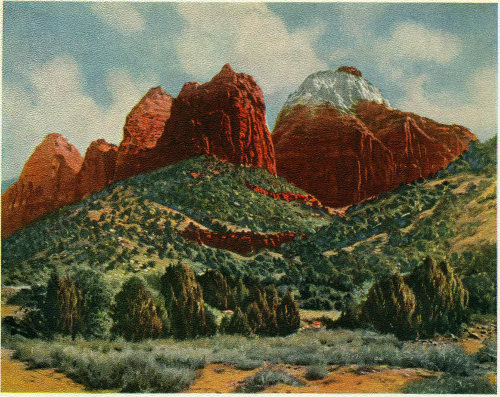
East Temple and the Twin Brothers, Zion National Park
What magic the morning and the evening sun performs on the pigmented palisades of this unique land! A dull rust red a moment ago, that distant peristyle now glows like fiery embers; the whites are more dazzlingly white and caressingly soft; the orange tones are enriched; the purple shadows swarm like birds. Colors flit mysteriously from salient to salient as if some one back stage were focusing spotlights. Dormant, crouching bulks rise, stretch and add to their girths, decking themselves in their most splendid raiment to bid farewell to the master of ceremonies, the vivifying sun.
Farther to the south is the Kaibab Forest and the North Rim of Grand Canyon, remote from traveled ways. Kaibab National Forest is the largest and most beautiful virgin forest in the United States. Beneath the stately pines, spruces and firs, the grassy forest floor is as clean as a carefully groomed lawn, and there are many open parks, aspen encircled, of bewitching charm. Numberless deer roam unmolested through this fairy forest and the rare white-tailed squirrel flits ghostlike through its aisles. There Roosevelt hunted and discriminating beauty-lovers have sought the region for years.
Words are of little avail to describe the Grand Canyon. Across the great plateau the Colorado River has cut a series of canyons about 220 miles long, a mile in depth and twelve miles in width. The Kaibab division is the deepest and wildest part of the Grand Canyon and presents its sublimest scenes. On the North Rim are some of the most celebrated of all the viewpoints, though known only to a few hundred adventurous travelers—Bright Angel Point, Point Sublime, Point Imperial, Cape Final and Cape Royal.
The way is now prepared for you to see these miracle places of America in comfort.
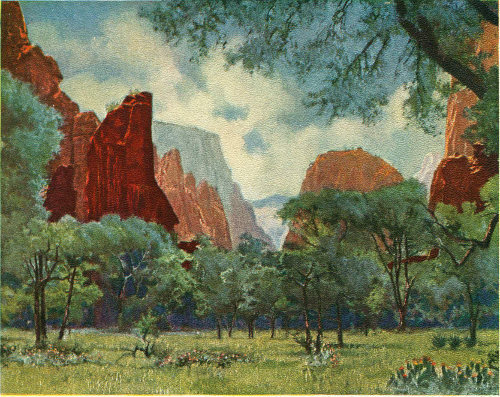
The Temple of Sinawava, Zion National Park
The highway southward from Cedar City (the Zion Park Highway) is on the floor of an arm of prehistoric Lake Bonneville. This is the Great Basin region, a sort of prison for running water because none of its streams ever reach the sea. In the east are the steep scarps of the Markagunt and Kolob Plateaus limited by a tremendous fault plane, the Hurricane Ledge; in the west are the Iron Mountains, veritable masses of iron ore; in the south are the lofty, majestic Pine Valley Mountains, extinct volcanoes whose dark, wrinkled summits exceed 10,000 feet in elevation.
Hamilton’s Fort, a few miles from Cedar City, was once a frontier outpost, the scene of several battles with Indians. Near the village of Kanarra the route passes over the rim of the Great Basin and enters the Colorado River watershed. Here Hurricane Ledge lifts more sharply into prominence, a precipitous rampart of gray and red rock mottled by piñons and junipers. The surface on which the road lies is the same as that on top of the ledge; the land in the valley either dropped hundreds of feet or the plateau was upthrust an equal distance. Hurricane Fault, as geologists call it, is the most striking displacement in the West. It extends from the volcanic Tushar Mountains, north of Cedar City, along the base of the Markagunt Plateau and southward across the Grand Canyon, a total distance of more than 200 miles.

Looking Toward the Narrows, Zion National Park
The road now follows Ash Creek, a tributary of the Virgin, over lava flows where prickly pears, pin-cushion cacti, yucca, torchweed and miner’s candlesticks grow among the sage brush. Thereabouts the first view is had of the Valley of the Virgin, Utah’s “Dixie,” a tumbled region of low mesas, black volcanic cones, lava fields and dunes of cherry-red sand, settled by Mormon colonists in 1858. This “Dixie” section of Utah, about 3,000 feet in elevation, is sub-tropical in climate, grows a large variety of agricultural products including cotton and tobacco, and its poplar-shaded villages have a quaintness suggestive of foreign lands. One of the most picturesque communities is Toquerville, named after an Indian chief, and where the automobiles stop so that the traveler may purchase for small sums an amazing variety of delicious fruit: figs, pomegranates, grapes, melons, almonds, peaches, pears, plums and apricots. Along the village street, with its double row of poplars planted as windbreaks, are odd houses of adobe fenced with stone, seemingly asleep beneath their luxuriant fig trees; irrigation streams gurgle and sing with the cool seduction of flowing water in an arid land. The scene has a pastoral air of Biblical peace and plenty. Three miles south, the Harding Highway crosses La Verkin Creek, turns eastward, and begins to climb.
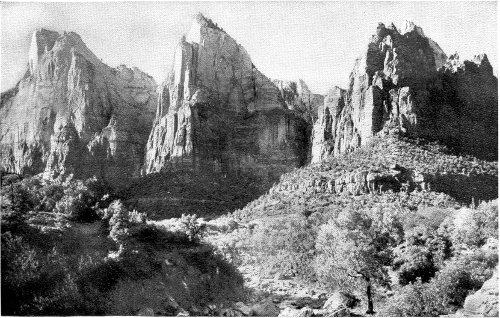
The Three Patriarchs, Zion National Park
In an instant the scene changes completely. Long, buttressed and fretted mesa promontories parade solemnly into view, an endless array of marching mountains banded with buff, red, pink and gray, mountains that seem to have come from nowhere. Soon arises across the gray-green sage the huge rock cathedral called Smithsonian Butte, spired with silver and gray; and then, instantaneously dominating the entire landscape, there appears, at the gates of Zion, the West Temple of the Virgin. The transcendent beauty of this tremendous tinted temple of stone is best realized when irradiated by the morning or afternoon sun. The southern facade of the structure forms a sundial for the villages near by. The finest description is that of Captain C. E. Dutton, a celebrated geologist who, while in the service of the government, wrote in 1880:
(Somewhat Abridged)
“In an hour’s time, we reached the crest of the isthmus, and in an instant there flashed before us a scene never to be forgotten. In coming time it will, I believe, take rank with a very small number of spectacles each of which will, in its own way, be regarded as the most exquisite of its kind which the world discloses.
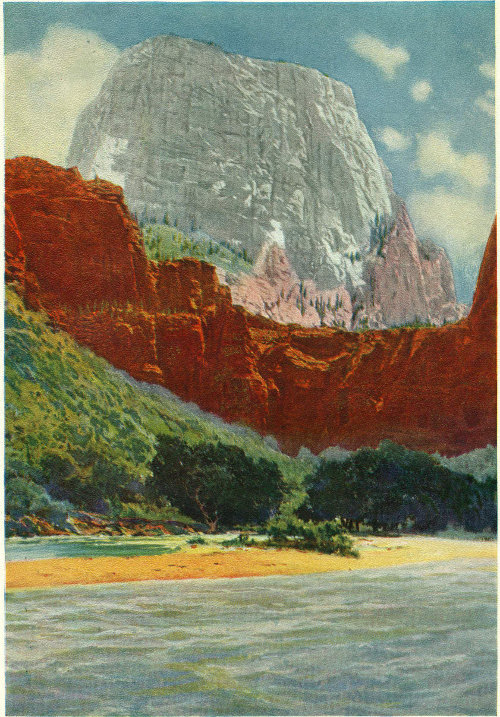
The Great White Throne, Zion National Park
“Across the canyon stands the central and commanding object of the picture, the Western Temple, rising 4,000 feet above the river. Its glorious summit was the object we had seen an hour before, and now the matchless beauty and majesty of its vast mass is all before us. Yet it is only the central object of a mighty throng of structures wrought up to the same exalted style and filling up the entire panorama. Right opposite us are the two principal forks of the Virgin, the Parunuweap coming from the east, and the Mukuntuweap, or Little Zion Valley, descending from the north. The Parunuweap is seen emerging through a stupendous gateway and chasm nearly 3,000 feet in depth. The further wall of this canyon swings northward and becomes the eastern wall of Little Zion Valley. As it sweeps down the Parunuweap, it breaks into great pediments covered all over with the richest carving. The effect is much like that which the architect of the Milan Cathedral appears to have designed, though here it is vividly suggested rather than fully realized. The sumptuous, bewildering, mazy effect is all there, but when we attempt to analyze it in detail it eludes us.
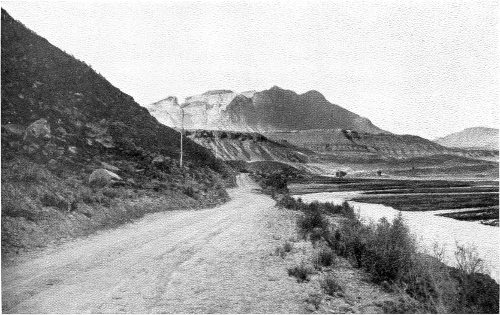
Distant View of the West Temple of the Virgin, Zion National Park
“The flank of the wall receding up the Mukuntuweap is for a mile or two similarly decorated, but soon breaks into new forms much more impressive and wonderful. A row of towers half a mile high is quarried out of the palisade and stands well advanced from its face. There is an eloquence to their forms which stirs the imagination with singular power and kindles in the mind of the dullest observer a glowing response.
“Directly in front of us a complex group of white towers, springing from a central pile, mounts upward to the clouds. Out of their midst, and high over all, rises a dome-like mass which dominates the entire landscape. It is almost pure white, with brilliant streaks of carmine descending its vertical walls. At the summit it is truncated and a flat tablet is laid upon the top, showing its edge of deep red. It is impossible to liken this object to any familiar shape, for it resembles none. Yet its shape is far from being indefinite; on the contrary it has definiteness and individuality which extort an exclamation of surprise when first beheld. Call it a dome; not because it has the ordinary shape of such a structure but because it performs the functions of a dome.
“The towers which surround it are of inferior mass and altitude, but each is a study of fine form and architectural effect. They are white above and change to rich red below. Dome and towers are planted upon a substructure no less admirable. A curtain wall 1,400 feet high descends vertically from the eaves of the temples and is succeeded by a steep slope of ever-widening 14 base-courses leading down to the esplanade below. The curtain wall is decorated with a lavish display of vertical mouldings, and the ridges, eaves and mitred angles are fretted with serrated cusps. This ornamentation is repetitive, not symmetrical. But though exact symmetry is wanting, Nature has here brought home to us the truth that symmetry is only one of an infinite range of devices by which beauty can be realized.
And finer forms are in the quarry
Than ever Angelo evoked!
“Nothing can exceed the wondrous beauty of Little Zion Valley, which separates the two temples and their respective groups of towers.”
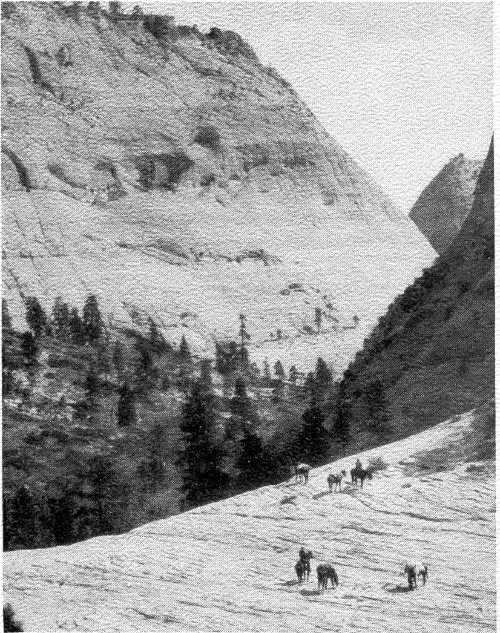
West Rim Trail, Zion National Park
But the traveler has not yet reached the gates of Zion, although distant views continue to appear and disappear. The Virgin River is now near at hand on the right, a swift, moody, meandering stream whose red waters are the creators of the fertile farms along its banks and sometimes their destroyers. The foreground landscape is red, although the broad, sloping buttresses of the mesas, folded, fluted and flounced ad infinitum, display buffs, yellows, grays, browns and purples.

Sentinel Peak, Zion National Park
Near Virgin City there is a view northeastward of sensational Guardian Angel Pass. Across Great West Canyon, apparently, stands an immense dam of rock cleft by a rectangular aperture as regular as if cut by engineers; surmounting the barrier are two towering white cones, the ghostly guardians of the gap. Another fascinating feature of the panorama is the complex convergence of the battlemented mesa promontories from all directions except the south; these carved and tinted headlands actually seem to advance upon the beholder. In the east are the pinnacled spires of the Eagle Crags, shattered to dagger sharpness.
Rockville, another village beside the Virgin, was founded by Mormon pioneers in 1861, and was long an important telegraph station. There is a petrified forest in the vicinity.
About five miles beyond, the two profound chasms, the Mukuntuweap (Zion) and the Parunuweap, converge; and the two sublime domes, the East and West Temples, with their incredible crests of crimson bleeding down their pale precipices, soar above the rushing waters. Springdale, the last Mormon hamlet, is passed; then the Ranger Station at the southern boundary of Zion National Park.
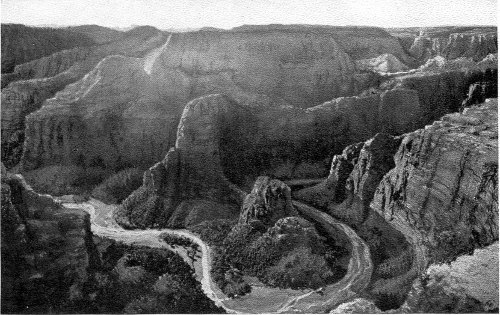
The Great Bend of the Mukuntuweap, Zion National Park
Zion National Park is a roughly quadrangular area of approximately 120 square miles, sixty-four miles by highway from Cedar City, and sixty miles on an air line north of the rim of Grand Canyon. It was set apart as a National Monument under its Indian name, Mukuntuweap, in 1909. In 1919 its area was enlarged, its name was changed to that given it by the Mormon pioneers, and it was made a National Park.
There are cliff dwelling ruins in Zion Canyon, more in Parunuweap Canyon, and the modern Indians had a reverent acquaintance with its solemn amphitheatres. Several interpretations are given of its Indian name, Mukuntuweap. Major Powell translated it “straight canyon;” another interpretation is “place of many waters;” still another is “place of the gods.” One legend declares that the Paru-sha-pats Indians once saw a light upon the West Temple and supposed it to be a signal fire to warn them of a Navajo raid. But they found that the West Temple is unscalable and decided that friendly rock spirits had produced a supernatural incandescence; and so, to them, it was “Rock-rover’s Land.”
It is certain that the Indians regarded Zion Canyon as a place sacred to spiritual beings; they laid their propitiatory offerings of flesh and fruit at the foot of the crimson crags of Sinawava and none would spend a night in their shadows.
Mormon colonists entered the region about 1858, began its patient reclamation by irrigation, and named the marvelous canyon Little Zion. Major Powell, the famous explorer-geologist reconnoitered the country in 1870. A few years later Captain Dutton studied it and in “The Tertiary History of the Grand Canyon District,” now out of print, presented a picture that is “a classic of inspired description.” From that time until 1909, except for the visits of a few artists and travelers of the adventurous type, Zion was practically unknown. It may now be visited in perfect comfort. Several colleges have sent classes there for summer study.
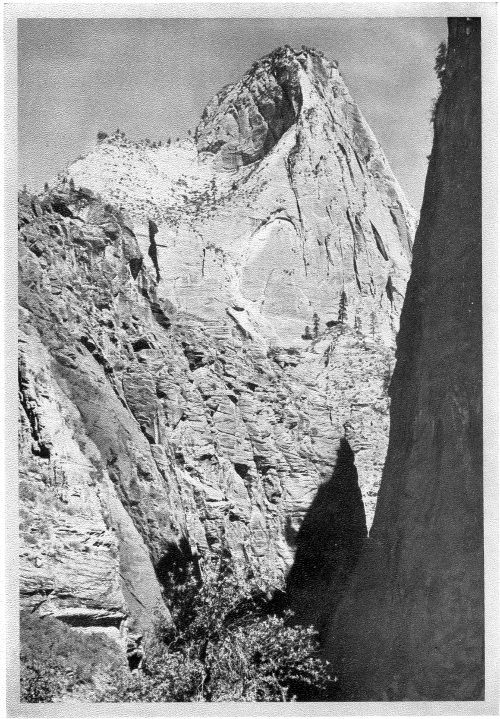
The Mountain of Mystery, Zion National Park
The outstanding feature of Zion National Park is Zion Canyon, the stupendous red and white gorge cut by the Mukuntuweap River from the Kolob Plateau through more than 3,000 feet of the Jurassic sandstones of the White and Vermilion cliffs and down into lower beds of mauve sandstone and shales of purple and red. The floor of Zion is 4,100 feet above sea level; the dome of the West Temple rises to 7,650 feet. The canyon is about fourteen miles long and varies in width from about a mile at Springdale to scarcely more than the reach of a man’s outstretched hands in the upper Narrows where the river has cut a channel under the towering cliffs. Imagine, if you can, the overwhelming effect of these painted precipices, nearly 2,000 feet high and both close enough to be touched without moving.
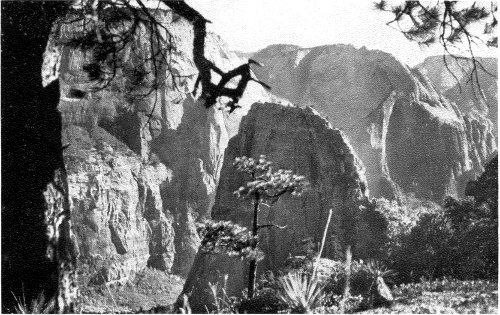
The Temples of Zion
In places the canyon widens into courts and shrines of bewitching beauty, such as the Court of the Patriarchs and the Temple of Sinawava. From the vermilion walls have been chiseled individual buttes and peaks of monstrous greatness and surpassing majesty, among them Angels Landing, the Great White Throne and the Mountain of Mystery. And these soaring scarps and summits present such varied tints and hues of red that the expert in pigments is bewildered; from the delicate pink of a baby’s cheek to deepest carmine, and beyond—from bittersweet and orient pink through orange chrome, flame-scarlet, vermilion, jasper, Pompeiian red and Indian lake to mahogany, ox-blood, maroon and a red that is almost black. In places the walls are topped with creamy white and the green of pines. Everywhere they exhibit a wizardry of massive sculpture. The deep-set river is bordered with the verdure of cottonwoods, box-elders, pines, ferns and flowering shrubs; in mossy caves curtained by little waterfalls, deer cradle their fawns. The radiance of the morning and evening sun upon the tinted towers of Zion is among the finest of its spectacles.
Standing upon the edge of the Park near Springdale is The Watchman, a stately cathedral-like pile of red sandstone. About a mile beyond is Bridge Mountain upon whose upper slope may be discerned a great bow of stone, a natural bridge with a span of 100 feet. Among the Towers of the Virgin stands the Altar of Sacrifice, a buttressed white fane whose summit and wall are stained deep with flowing crimson, suggesting the bloody sacrificial place of some insatiable pagan god. The East Temple, on the right, is a splendid structure of pink and white surmounted by a carmine capstone.
On the left is the Streaked Wall bearing strange white cones, and beyond it is Sentinel Peak. The west wall then recedes to form the fine Court of the Patriarchs whence rise the three stately Patriarchs themselves, jagged pink and white 18 pyramids. Above the east wall stand the Twin Brothers and the Mountain-of-the-Sun, the latter the first to glow in the light of dawn, the last to hold the evening rays. Lady Mountain, Mt. Majestic and Red Arch Mountain next appear, and Angels Landing, a sharp-shorn, pyramidal wedge of Pompeiian red that projects boldly into the canyon and throws off from its foot a fluted ox-blood mass called the Great Organ. Round this the river winds in a serpentine semicircle.
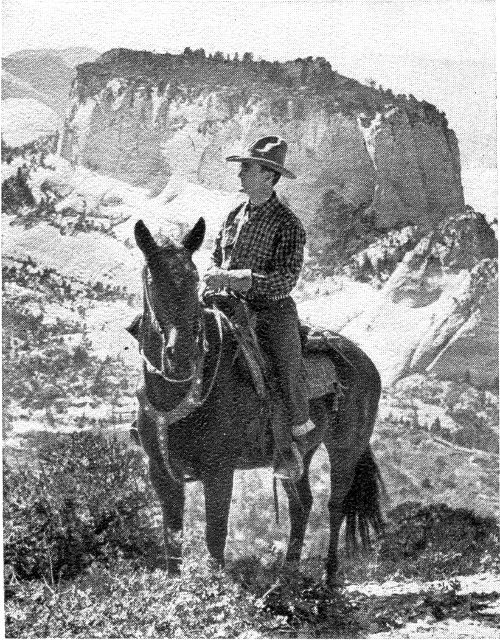
On the West Rim, Zion National Park
Just below the great bend in the Mukuntuweap River looms an isolated rock temple of prodigious bulk and imperial majesty, a truncated pyramid or mayhap a flattened dome, its lower half red, its upper half tinting from rosy buff to white, a forest of tall pines, acres in extent, upon its untrodden summit. This colossal butte, “one of the world’s great rocks,” is seen most effectively from the Temple of Sinawava, through the inverted maroon arch between the Great Organ and Angels Landing. It appears completely detached from the east wall, aloof and unscalable. While it has not been officially measured, its crest is probably more than 3,000 feet above the river.
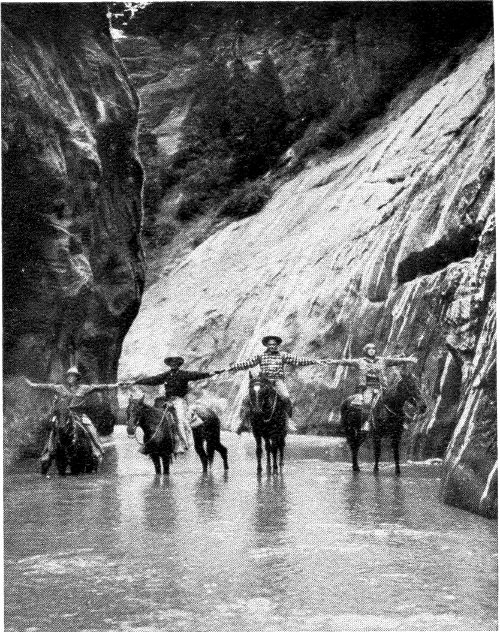
In the Narrows, Zion National Park
To the north is Cable Mountain, whence a rope of steel wire conveys lumber to the valley from the forested plateau. Between it and the next peak is Raining Cave and the site of a cliff dwelling.
Beyond the bend the precipices of jasper red confine a flower-dotted meadow shaded by trees, where sphinx-like figures, colossi, and shattered pylons of warm and sombre reds suggest the Egyptian ruins at Karnak and Thebes. Several obelisks rise isolated from the gardens of the shrine. This is the beautiful Temple of Sinawava, the last of the courts as one ascends the Canyon. It was here that President Harding paid his tribute to Zion in 1923.
Half a mile beyond, the dragon’s-blood precipices become more perpendicular and close in toward each other until the gorge seems blocked, but a turn opens new vistas. Now, it is no more than seventy-five feet from cliff to cliff and the stream stretches from wall to wall. But there is one last glorious picture for those who must turn back. A short distance farther up the gorge soars a slender, ethereal cone of pink and 19 white, a peak of such appealing symmetry and delicate tints, so lofty and aspiring, that it evokes a cry of admiration. It is the Mountain of Mystery.
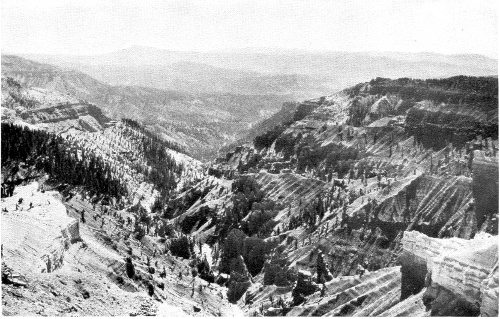
One of the Amphitheatres of Cedar Breaks
The Canyon continues some eight miles farther, but its exploration is only for the adventurous few. There is no trail but the winding river which reaches from wall to wall; sudden rainstorms send between the scarred and splintered cliffs a resistless torrent of water. With a competent guide those in search of unusual thrills may ride horseback several miles into the deep sunless cleft where great pendants of rock overhang and shut out the sky; where the churning stream in flood has left intricate cameos and arabesques upon the sandstone; where little waterfalls leap from green ledges; where one may almost touch both sombre walls with outstretched hands; where the stars may be seen by day. Many a time the canyon seems to end with prison-like finality and the sky seems lost forever. It is a travel adventure that may not be had elsewhere and one never forgotten.
Seen from above, the aspect of Zion is wholly different. Instead of a relatively straight and orderly canyon dominantly red in color, it becomes a fantastic maze of white and variegated buttes and cones. Mr. Hal G. Evarts thus described in The Saturday Evening Post his impressions from the West Rim:
“It seemed that we gazed out across some vast oriental city that stretched away for a dozen miles. Scores of gaudy mosques and tinted towers, striped citadels topped by flat-roof gardens rose in countless tiers from this congested, painted metropolis.... And the coloring! Imagine a tremendous city of spires and turrets ..., its buildings catching every dazzling reflection of the sunset.... There were soft apricot and salmon tints, vague pinks and creams; lemon blending into deepest orange, ... with here and there a haunting suggestion of pale mauve. Brilliant red spires stood beside domes of ivory white. In many of these fairy structures the stratifications pitched so abruptly as to lend a spiralling, barber-pole effect....”
And Zion Canyon is but a part of Zion National Park.
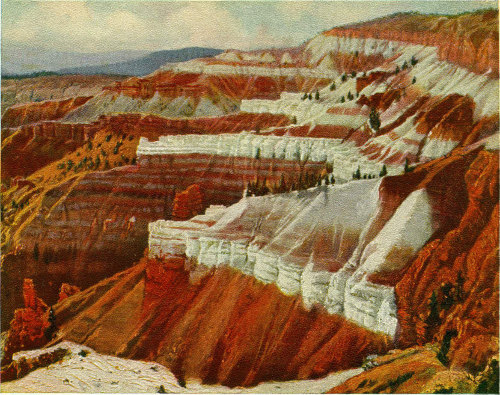
The Painted Buttresses of Cedar Breaks
Cedar Breaks is twenty-three miles by highway east of Cedar City and four-fifths of a mile nearer the sky. Immediately east of the town the road enters the rugged gorge of Coal Creek, its slopes covered with fine forests of conifers and aspens. The walls assume impressive castellated forms that are especially striking at the mouth of Ashdown Gorge, eight miles distant. Ashdown Gorge is an extremely narrow, tortuous and precipitous rift in the plateau, down which rushes a sparkling stream from the vast furrows of Cedar Breaks. About one mile from the mouth and high up the precipice is a natural bridge with an arch of about sixty feet and a span of about seventy feet.
Following Coal Creek, ever upward, the road presently occupies a shelf upon the shoulder of the Markagunt Plateau whence are revealed glorious and almost illimitable panoramas. The whole sweep of the Terraced Plateau country to the south is visible. Some twenty-five miles directly south, slashed into the green of the Kolob Plateau, are the mazy, white-topped temples and towers of Zion, the grand West Temple dominating the scene. The sinuous profiles of the Pink, White and Vermilion Cliffs are discernible; the hazy arch of the Kaibab; and the misty dome of Navajo Mountain, beyond the Colorado. Several volcanic peaks are in the foreground.
This immense range of visibility is one of the strong attractions of the Terraced Plateau country; one sees again and again, in new and startling aspects, the salient features of hundreds of square miles of territory and its spectacular geological structure.
At Midway the road turns northward for three miles through stately pines, firs and spruces and comes without warning to the abyss named Cedar Breaks.

Cedar Breaks
Cedar Breaks is a series of vast amphitheatres eroded to a depth of 2,000 feet into the Pink Cliff formation at the summit of the Markagunt Plateau and covering an area of approximately sixty square miles in the Sevier National Forest. Its forested rim, 10,300 feet in elevation, has been etched back into Blowhard Mountain and adjacent eminences; and a short distance to the north the blunted volcanic crest of Brian Head rises 900 feet higher, affording a panorama of practically all of southern Utah, Nevada and northern Arizona.
Within its limitless labyrinths countless millions of grotesque and magnificent architectural forms, anointed with all the colors of the spectrum, flash into the eyes of the beholder. The erosional structures are blends of Egyptian and massive medieval Gothic walls, modified in a thousand surprising and original details, and rising generally from far-flung, wedge-shaped base courses of white and orange. The colors change marvelously in response to the sun; pink is dominant, though, at times, orange tones seem to prevail. In broad aspect the color scheme is pink, red, orange, yellow, white, lavender and purple, with intermediate tints and hues that would form a dictionary of pigments; and on the countless scalloped slopes appears the green of spruces, firs and pines. An artist has counted more than sixty tints in Cedar Breaks.
There are six or seven great amphitheatres, semicircular or three-quarter circles in shape, with sharp ridges radiating from rim to center; the few trails into the abysmal serrate basins are faint and obscure, yet the descent with a guide offers unsuspected marvels; then only does one comprehend the immensity and the variety of Cedar Breaks.
Along the rims are several easily reached viewpoints, among them Point Supreme and Point Perfection. Conspicuous in the 22 welter of forms below are innumerable red, castellated bastions in parallel rows; long, writhing dragon-like forms of pure white; and huge sprawling dinosaurs covered with blood. For all its beauty, the place might appropriately have been the habitat of prehistoric monsters. The panoramas westward across the deserts of the Great Basin are notably fine.
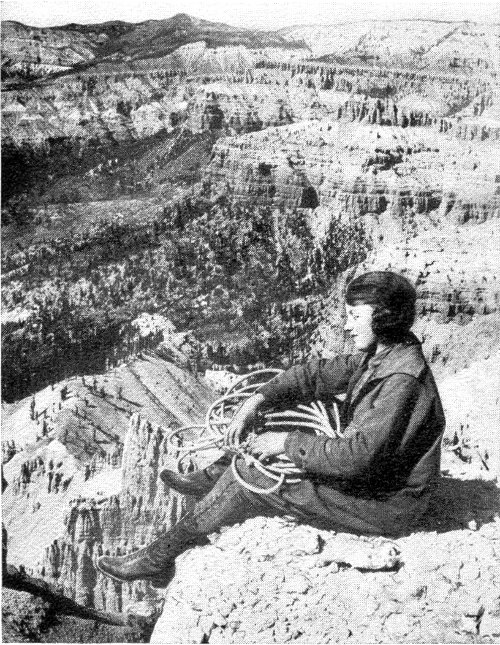
On the Rim, Cedar Breaks
In vastness, in variety of color, in wild grandeur, Cedar Breaks is the greatest of Utah’s painted amphitheatres.
It is seventy miles from Cedar Breaks to Bryce Canyon. Crossing the broad summit of the Markagunt Plateau the highway traverses fine coniferous forests that frequently open into charming “parks,” and passes great areas covered with lava from Hancock Peak and the adjacent extinct volcanoes. Navajo Lake, a beautiful mountain tarn encircled by pines and a noted fishing water, is about eight miles beyond Midway.
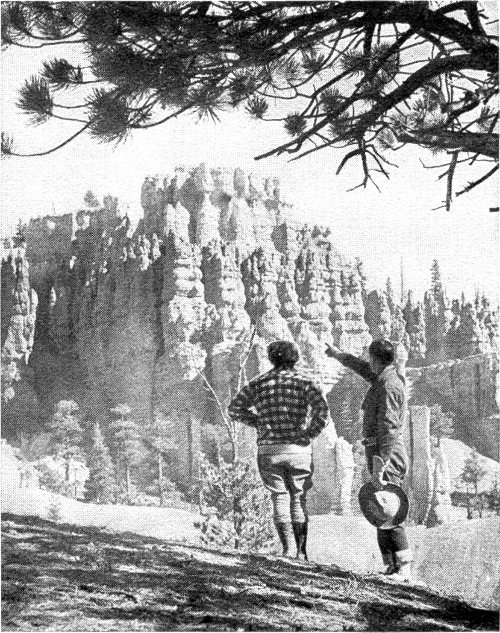
One of the Countless Castles of Bryce Canyon
Soon pretty Duck Creek, rising in full power from a fine spring and filled with trout, parallels the highway for several miles, then disappears under the volcanic rock. At the crossing of Strawberry Gulch a little used trail extends southward to Strawberry Point, a famous observation place on the Pink Cliffs. The main highway is alternately surfaced with white, pink and red rock, a painted road in a land of color.
At Cedar Breaks Junction, the route turns north, following the head waters of the Sevier River, one of the most important streams of the Great Basin; to the eastward, in the vicinity of Hatch, vistas of the Pink Cliffs appear. Then the road crosses the Sevier and enters Red Canyon.
The rich red turrets and towers at this canyon gateway are harmonious introductions to the greater glories of Bryce. Once within its narrow defile, the superb portal broadens into a little pine-dotted valley and its walls display hundreds of spires, windowed walls, bridges, columns and statue-like shapes of pink and ruby. The road, often running through arches in the red cliffs, is as smooth as a boulevard. Next, the route leads out upon the level, treeless surface of the Paunsaugunt Plateau, and comes with startling unexpectedness to one of the splendid amphitheatres of the Pahreah Basin.
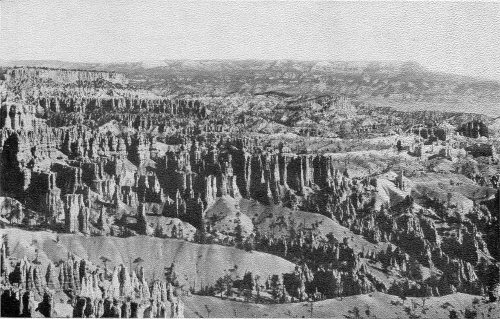
Bryce Canyon National Monument
Probably Bryce Canyon is the most astonishing blend of exquisite beauty and grotesque grandeur that the forces of erosion have ever produced. In one aspect it is a gorgeous lacework design of frost and fire, the playground of sylphs and fairies; in another it is a smoldering inferno habited by goblins and demons; again, it seems as if some cataclysmic force had shuffled together a dozen oriental cities into one spectacular municipality. The joyous prevailing colors of this immense bowl of luminous, flickering filigree heaped with jewels, are pink, red, orange, purple, yellow and white; to these may be added as many other tints and tones as one has patience to distinguish. Though Bryce is immense, yet it is intimate, presenting to the eye a scintillating coral intaglio of bizarre but definite plan, overspread with a halo of lavender mist.
It is not a canyon, but an amphitheatre of horseshoe shape, graven 1,000 feet deep into the sandstones on the eastern edge of the Paunsaugunt Plateau, at the headwaters of the Pahreah River; it is approximately two miles wide and three miles long and its rim is 8,000 feet in elevation. The area of Bryce Canyon National Monument, which was created in 1923 and is administered by the U. S. Department of Agriculture, is 7,440 acres.
In the maze of architecture uprising from Bryce’s sunken gardens, where pine, spruce and manzanita spread their greens, there are the styles of China and Egypt, of the Toltecs, Incas, Greeks and Goths; but stronger, perhaps, is the resemblance to those decaying Dravidian temples, bursting with decoration, in the jungles of Burmah and Java: pagodas, mosques, minarets, kiosks, fairy castles, cathedrals, theatres, flying buttresses and stairways, suspension bridges, niched and fenestrated walls, peristyles, colonnades, lotus columns, leaning towers, slim spires, massive pylons, pyramids, obelisks, pilasters capped by tilted disks, cones supporting cones, organs, shrines and altars. All of the architects of antiquity might have drawn their inspiration from the silent cities of Bryce.
And these dream-tissue cities in the realm of muted mystery have weird inhabitants statued in variegated stone: giants and gnomes, popes and queens, kneeling penitents, companies of marching soldiers, gargoyles, fauns, satyrs, nymphs, witches, horses, dogs, lizards, frogs and turtles—figures that seem to move, sway and posture in the flashing play of light and shadow. The least vivid imagination needs a checkrein.
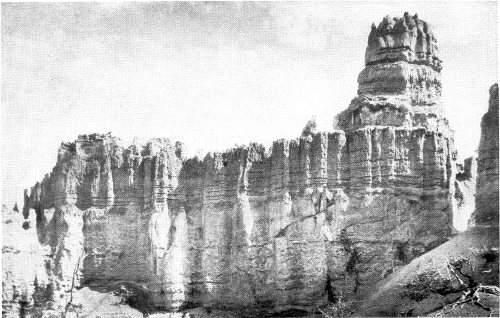
The Cathedral, Bryce Canyon
In the east, on a headland of the Table Cliffs, an outlier of the vast Aquarius Plateau, the mesa rises by ramps and colonnades of pink and buff to a level esplanade where stand a dozen glorified Acropolises,—façades, friezes, pillars and porticoes, in ruins of rosy marble. There, as everywhere, the marionettes of the sun continually perform their evanescent dances. And this is but a vista chosen at random from a hundred glorious panoramas.
Farther in the east, the amphitheatre opens out to make way for the headstreams of the Pahreah River; the green fields surrounding the village of Tropic may be seen and the ramparts of the Kaiparowitz Plateau.
Bryce should be seen from the west rim in the morning, from the east rim in the afternoon. The exquisite pageant of shimmering tints begins when dawn thrusts the first spears of light into the abysses. The best effects are obtained when the formations are between the beholder and the sun; it is then that the mysterious, lambent flames flicker in the distant temples and play upon altars and columns, warming them into living, glowing color. Trails extend in both directions along the rim of the Canyon from Bryce Lodge and the vistas change with almost every step taken.
Sunset upon Bryce Canyon is another breath-taking manifestation of Nature’s magic, followed by a solemn twilight of the innumerable gods that dwell there in pomp and splendor. The visitor should see both dawn and dusk transform the great amphitheatre, and should see it sleeping in the noonday light.
Every visitor should take the trail into the depths of Bryce Canyon, either on foot or horseback. Lacy designs and dainty figures, seen from the rim, assume huge proportions when one is amongst them; there are sunless grottoes and shadowed crypts, wafer walls pierced by many windows, artists’ studios filled with half-finished models and figurines, innumerable fantastic forms in bronze, jasper, ruby amethyst, topaz and alabaster. Each turn in every innumerable aisle, alley and corridor on Bryce’s intricate floor has its charming revelations of unimagined contour and color.
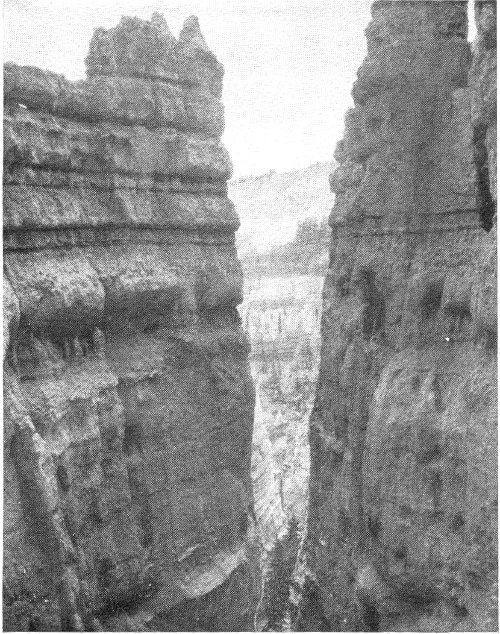
Trail into Bryce Canyon
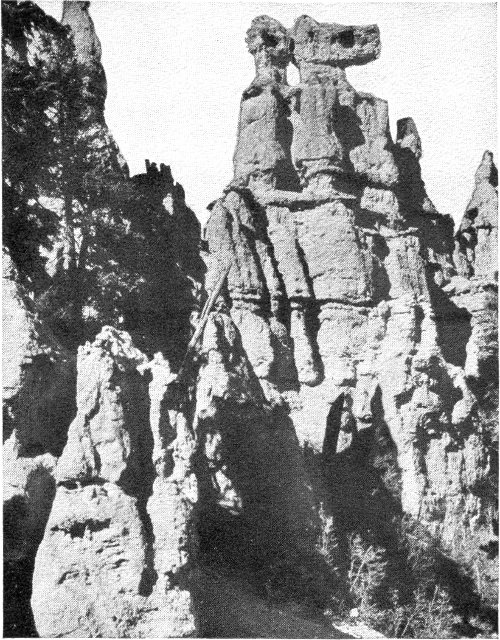
Pillars of Pegasus, Bryce Canyon
The highway crosses the Rio Virgen at Rockville and climbs the plateau, whence splendid views may be had of the Temples of Zion. Near the Arizona boundary appear the magnificent Vermilion Cliffs which stretch across Southern Utah for great distances; they present the arresting architectural effects of vast castles and cathedrals colored rich red which becomes vivid vermilion in the afternoon sun.
After crossing Short Creek into Arizona the immense blue arch of the Kaibab Plateau becomes more prominent and Mt. Trumbull, an extinct volcano overlooking Grand Canyon, looms in the purple distance. Upon this stretch of fascinating desert range many wild horses, direct descendants, perhaps, of those brought to America by the Spaniards. On Cedar Ridge is a petrified forest.
The road follows the Vermilion Cliffs eastward through the Kaibab Indian Reservation to Pipe Spring, a celebrated oasis on the plains, created a National Monument in 1923. The two historic stone buildings standing there were erected more than fifty years ago in fortress style for protection from the Indians; from beneath one house flows the finest and purest spring in all this frontier domain, daily discharging 100,000 gallons of cool water.
At Pipe Spring, the Vermilion Cliffs recede northward and give place to the Shinarump Cliffs, banded with gorgeous colors—red, brown, lavender, chocolate and white. A conspicuous butte seen approaching Fredonia is The Battleship. Fredonia is a pretty little Mormon community of 300 inhabitants and the only town in Arizona north of the Grand Canyon.
Between Fredonia and the Kaibab is one of the most picturesque and exquisitely colored stretches of upland in America. Whites, blacks, browns, yellows, pinks, purples, reds and all their pale intermediate tints are splashed over these prismatic plains, where cactus, yucca, piñon, sage and cedar somehow find sustenance.
Almost imperceptibly, the automobile has climbed the gentle slopes of the Kaibab. Looking backward to the north one of the grandest spectacles of the Plateau Country is unfolded. Nearly 10,000 feet of terraced rock layers are exposed edgewise across a frontage of some sixty miles. A glorious panorama, these painted precipices! First the rainbow Shinarump, then the Vermilion, White and Pink cliffs, tier upon tier and hundreds of miles in convoluted length, all shining and shifting in the sun.
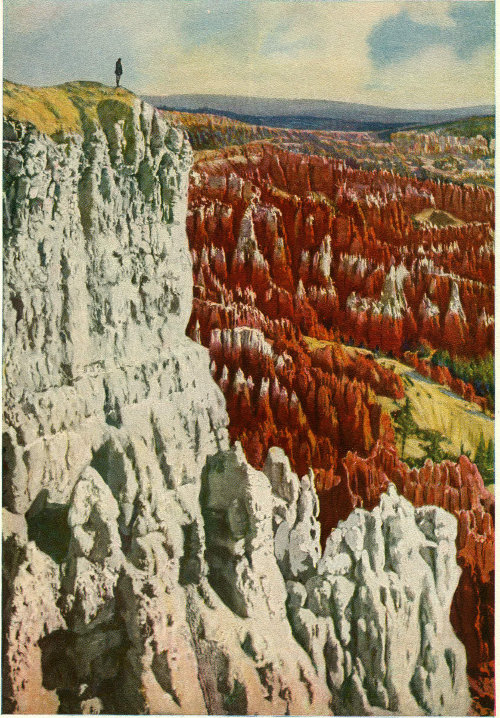
Bryce Canyon from Inspiration Point

The Temple of Osiris, Bryce Canyon
Beautiful as are the plains, the transition to the limitless park-like forests of the Kaibab is a welcome delight. Kaibab is a Piute Indian word meaning “Mountain-lying-down,” a description that fits it well. It is actually a vast plateau, some fifty miles long and thirty-five miles wide, and containing 500 square miles of yellow pine, fir and spruce diversified by charming aspen copses, the largest and most beautiful virgin forest in the United States. In elevation it rises from 7,500 to 9,300 feet above sea level.
Kaibab Forest occupies the top of a lofty plateau isolated on the south and east by the Grand Canyon, on the north and west by the mysterious plains above which it rises 5,000 feet. On all sides are unexplored plateaus and canyons where untouched cliff dwellings stand. Beneath its stately trees the grassy forest floor is free from underbrush and fallen timber, as clean as if raked daily by ten thousand foresters; and, although they are not widely distributed, there are many lovely wild flowers and ferns. Scattered throughout its great extent are spacious “parks,” green-swarded, treeless open spaces bordered by white-boled, quivering aspens, the advancing light cavalry of an innumerable army of deploying pines. The witchery of these sylvan plaisances is wholly irresistible; they seem designed for parades and pageants, for the light-hearted moods of man and beast.
And so, indeed, they are employed. Afternoon and morning they are the gathering places of many of the 30,000 black-tail mule deer that range unfrightened through the forest. They do not require patient stalking to be seen; crossing the forest one may usually count several hundred haughty bucks, solicitous does, and adorable prancing fawns of exquisite grace. Their only enemies are the cougars, much reduced in number by “Uncle” Jimmy Owens, the 30 government hunter who was Roosevelt’s guide, and other official huntsmen. Second in interest of the Kaibab’s creatures is the white-tailed squirrel (Sciurus Kaibabensis) which may ordinarily be seen flickering through the forest near Jacobs Lake Ranger Station. This is the most beautiful squirrel in the Western Hemisphere, and one of the rarest, for it lives nowhere else. It is about the size of a large gray squirrel, though shorter and stockier, is dark bluish gray marked with brown, has long tufted ears and a broad feathery tail that is almost pure white. Cougars and mountain sheep are rarely seen by the ordinary traveler. Captain Dutton wrote of a visit to the Kaibab in 1880: “It is difficult to say precisely wherein the charm of the sylvan scenery of the Kaibab consists. We, who through successive summers have wandered through its forests and parks, have come to regard it as the most enchanting region it has been our privilege to visit.
“There is a constant succession of parks and glades—dreamy avenues of grass and flowers winding between sylvan walls, or spreading out in broad open meadows.... The balmy air, the dark and sombre spruces, the pale-green aspens, the golden shafts of sunshine shot through their foliage, the velvet sward—surely this is the home of the woodland nymphs.”
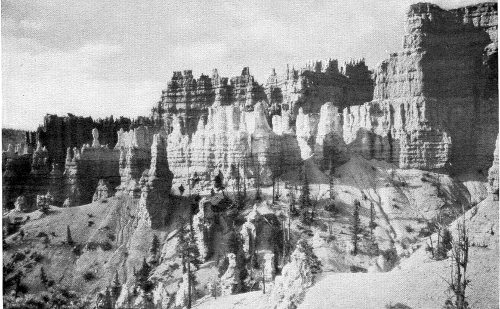
The Filigreed Walls of Bryce Canyon
The Grand Canyon is the supreme epic of erosion; there water has perpetuated its sublimest masterpiece in stone. “The Grand Canyon fills me with awe,” wrote Roosevelt. “It is beyond comparison—beyond description; absolutely unparalleled throughout the wide world.” “Wildness so Godful, cosmic, primeval, bestows a new sense of the earth’s beauty and size,” said John Muir. “By far the most sublime of all earthly spectacles,” is the opinion of world travelers who have studied its grandeur.
The Grand Canyon may be described as a vast and intricate range of sunken mountains cut through a hundred miles of high plateau, “a mountain chain reversed.” Usually it is pictured as a colossal chasm, 220 miles in length, a mile deep and some twelve miles wide; but it is more precisely a measureless labyrinth of canyons with an infinite array of magnificent architectural forms upthrust from their depths. Deep down in the uttermost gorge of granite, the Colorado, “the rushingest, roaringest” river in the land, grinds ceaselessly at the 31 rocks. Numberless rich and vivid tones of gray, green, blue, red and mauve tint its mighty walls and temples, and, independent of these, the sunlight pours daily into the chasm a shifting color parade of exquisite blues and purples, glowing reds and golds.
Of the Kaibab division of the Grand Canyon, Captain Dutton states: “It is the sublimest portion of the chasm, being nearly a thousand feet deeper than any other, far more diversified and complex and is adorned with a multitude of magnificent features, either wanting or much less strongly represented elsewhere.” According to the U. S. Geological Survey, the Kaibab division is from seven to fourteen miles wide and from 5,300 to 6,000 feet deep. The elevation of the North Rim is from 8,000 to 9,000 feet and it is eroded extensively into tremendous lateral gorges and amphitheatres. The North Rim has the incomparable Kaibab Forest, uncounted unexplored cliff dwellings, and a summer climate distinguished by unfailingly cool nights. Along its winding edge are a number of noted capes and headlands that reveal some of the grandest aspects of the Canyon.
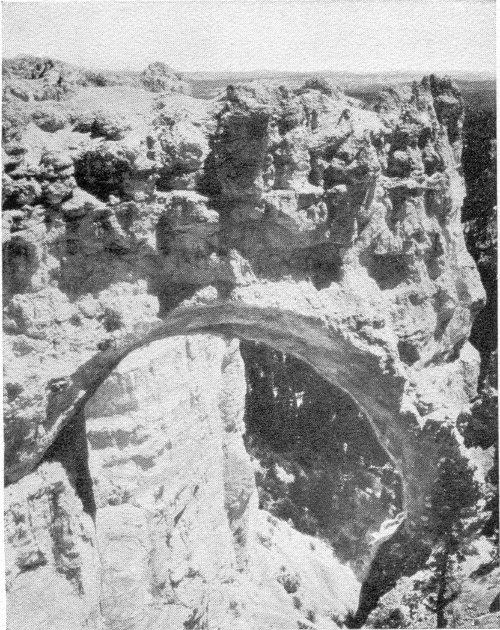
Natural Bridge, Bryce Canyon
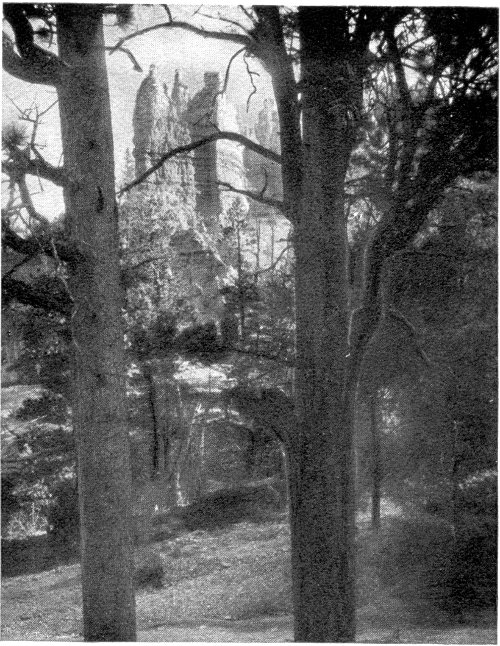
Bluebeard’s Castle, Bryce Canyon
Bright Angel Point stretches out between the Transept and Bright Angel Canyon; from its dizzy tip may be seen many of the finest temples: Deva, Brahma, Zoroaster, Wotan’s Throne, Manu, Buddha, Isis, Angels Gate and Cheops Pyramid. Near by is a picturesque spring with a perfectly preserved cliff dwelling adjacent. The Kaibab Trail descends from the Point to the Suspension Bridge across the Colorado River, where it joins the Bright Angel Trail to the South Rim.
Cape Royal, Cape Final and Point Imperial are on the huge Walhalla Plateau (locally called “Greenland”) southeast of Bright Angel Camp, and each reveals panoramas of greatest grandeur. Point Imperial, the highest place on the Rim, affords views of the Marble Canyon, Lee’s Ferry, Navajo Mountain and Houserock Valley. The wonderful views from Cape Royal extend west, south and east over the templed gorge. On the way to Cape Royal are Cliff Spring, many cliff dwelling ruins and Angels Window.
Point Sublime, west of Bright Angel Point, is another celebrated viewpoint, esteemed by Dutton to surpass all others. Thence may be seen the Hindu and Aztec amphitheatres, Powell Plateau, the Dragon, the Scorpion, and imperial Shiva, perhaps the most magnificent of all the Canyon’s glorious temples.
Every visitor to the North Rim of Grand Canyon should make the trip to Cape Royal and Point Sublime.
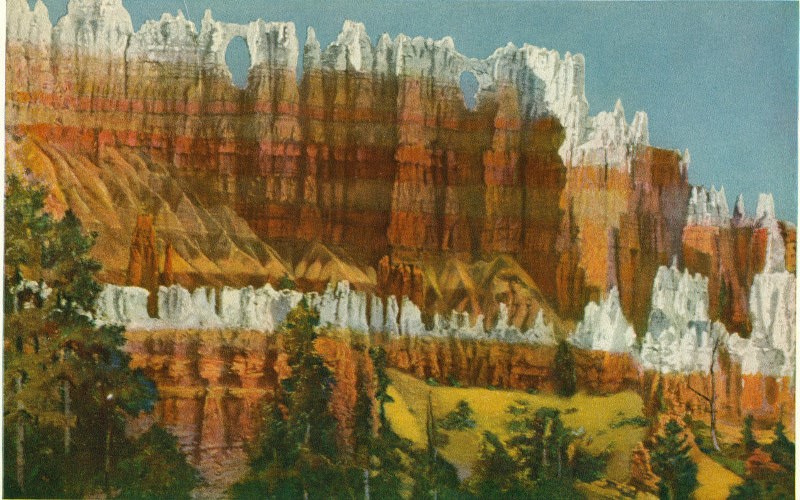
The Wall of Windows, Bryce Canyon
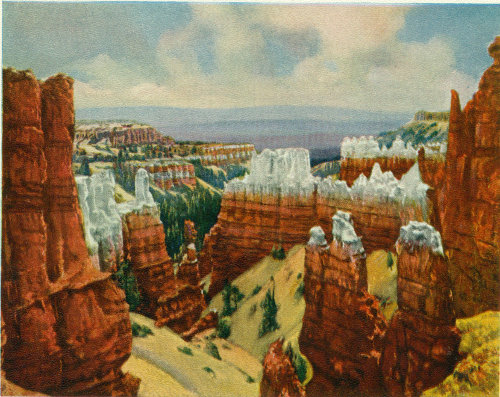
The Sculptor’s Studio, Bryce Canyon
The route between Fredonia and the North Rim has been described on the foregoing pages. North of Fredonia the way leads to Kanab, Utah, a thriving village at the foot of the Vermilion Cliffs and 120 miles from the nearest railroad. Thence it continues through the Vermilion Cliffs by way of picturesque Three Lakes Canyon, across dunes of pink sand, and down to the canyon of the Parunuweap, cut through the majestic White Cliffs. Splendid panoramas of the temples and towers of Zion are disclosed.
The highway follows Parunuweap River through Long Valley to its source, passing the Mormon villages, Mt. Carmel, Orderville and Glendale. The regions traversed are of unusual and unflagging scenic interest; many of the rugged and tortuous side canyons, which contain cliff dwellings, give glimpses of impressive formations.
The traveler ascends the Terraced Plateaus from the Shinarump and the Vermilion to the Pink Cliffs, vivid exposures of which, capped by lava, may be seen on distant eminences. Chamberlain’s Lake, north of Glendale, is a deep, cold tarn fed by a great spring. At Cedar Breaks Junction the road crosses from the Colorado drainage system into the Great Basin. The remainder of the route to Bryce Canyon has been described on page 22.
Zion National Park, Bryce Canyon National Monument, Cedar Breaks, Kaibab National Forest and the North Rim of Grand Canyon are reached via the through service of the Union Pacific System by way of Lund, Utah, to Cedar City, Utah, the 34 railroad terminus. Lund is on the main line of the Union Pacific to Southern California, 243 miles southwest of Salt Lake City, 541 miles northeast of Los Angeles. From Lund a branch line of the Union Pacific extends thirty-three miles southeastward to Cedar City. During the season through sleeping cars are operated from Salt Lake City to Cedar City and all through trains will stop at Lund, whence there is direct connecting service to Cedar City.
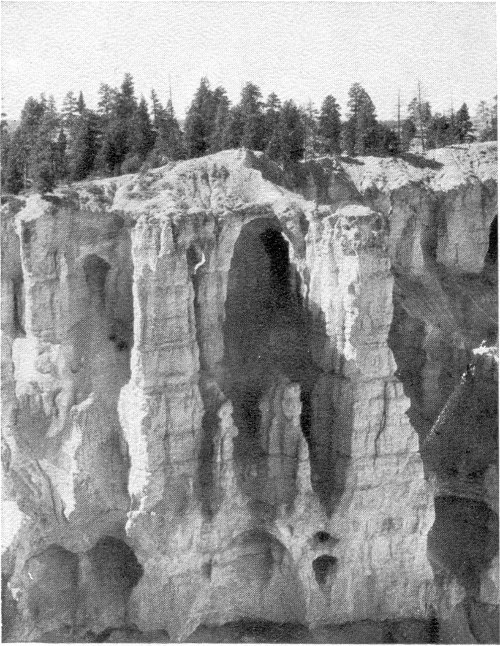
The Goblins’ Grotto, Bryce Canyon
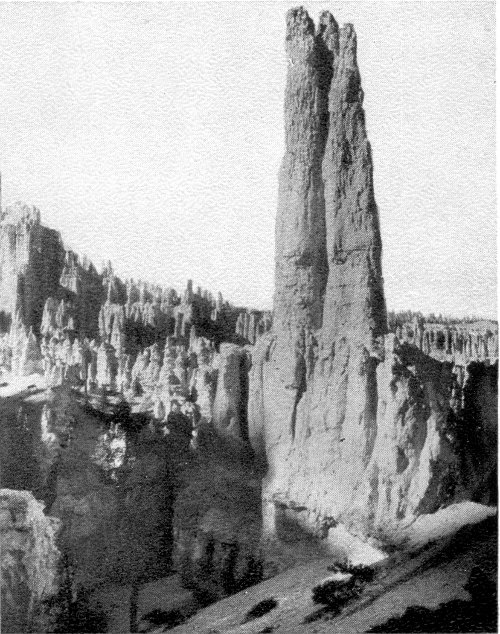
Spires and Minarets, Bryce Canyon
Very low round-trip Summer Excursion Fares, with liberal limits and stop-over privileges, are in effect during the season to Cedar City and the scenic regions of Southern Utah. Likewise, low side-trip excursion fares to Cedar City and return are available for Pacific Coast passengers traveling via the Union Pacific System; $2.10 from Lund for those en route to or from Southern California, and $13.75 from Salt Lake City for those en route to San Francisco, the Pacific Northwest or Yellowstone Park, during the season.
From Cedar City the Utah Parks Company, a subsidiary of the Union Pacific System, operates on regular schedules during the season a fleet of powerful eleven-passenger automobiles of the latest and most comfortable design to Zion National Park, Cedar Breaks and Bryce Canyon National Monument. Automobiles of the Utah & Grand Canyon Transportation Company (operated independently), also maintaining regular schedules, connect at Zion Park and at Bryce Canyon for the Kaibab Forest and the North Rim of Grand Canyon. There are good roads, constantly being improved, between Cedar City and Zion National Park, Cedar Breaks and Bryce Canyon National Monument; the roads between Zion Canyon and Bryce Canyon and the North Rim of Grand Canyon are fair, safe to travel, and are also undergoing improvement. Excellent lodges and camps are maintained at places where stop-overs are desirable.
The schedules of the automobiles, fares, accommodation at lodges, etc., are shown in detail on pages 39 to 43. Advance reservations made through any Union Pacific representative listed on page 47 will insure accommodations in automobiles, as well as at the lodges and camps. Inasmuch as the trip to Zion, Bryce and the North Rim of Grand Canyon is one of unusual character, unlike, in fact, any other in the United States, the traveler is urged to use the services of a Union Pacific representative in planning his itinerary. This may be done by letter, telephone or personal call; there is no charge for the service.
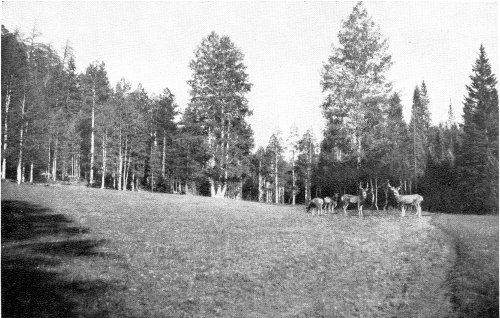
Deer in Kaibab National Forest
The season in Zion National Park is from May 15 to October 15; at Bryce Canyon and the North Rim of Grand Canyon from June 1 to October 15. Dates of operation and conditions are shown in connection with all tours on pages 39-40-41.
The climate in Zion National Park is mild throughout the season. At Bryce Canyon and Cedar Breaks, farther north and at higher elevations, cool weather may be expected at night both early and late in the season. In the Kaibab Forest and at the North Rim of Grand Canyon, cool nights are to be expected.
Southern Utah and Northern Arizona are regions of clear, dry, sunny days, delightfully exhilarating and followed by refreshing nights. There are occasional showers throughout the country during the summer season.
All automobile tours start at Cedar City, Utah, a prosperous and picturesque Mormon city of 3,000 inhabitants, on the edge of the Escalante Plain, at the foot of the Markagunt Plateau, at an elevation of 5,750 feet. Coming from Lund, one may glimpse in the distant east and nearly 5,000 feet above him, some of the rosy palisades of Cedar Breaks.
Cedar City has a good hotel, water system, electric lights, a bank, photoplay theatre, well stocked stores, hospital, Carnegie Library, Mormon Tabernacle, a branch of the State Agricultural College, and a new and handsome railway station. On the edge of the town is a band of Piute Indians, the original inhabitants of the country, who sell buckskin gloves, moccasins and other articles. The prosperity of Cedar City is derived from sheep, wool, cattle, agriculture and the recent development of vast deposits of iron in the Iron Mountains, twelve miles away. The community, founded by Mormon leaders in 1851, was named from the abundance of cedar trees in the vicinity.
This handsome new Union Pacific hotel at Cedar City would be an outstanding establishment in a metropolis. It is a three-story 36 structure of cream brick with sweeping wings and a broad verandah; seventy-five guest rooms with tub and shower baths; a spacious dining room; a banquet room, ballroom, billiard room, barber shop, and a luxurious lobby. The dining-room service is of the highest metropolitan standard and many delicacies from the local markets are included in the menus. El Escalante Hotel, named after Padre Sylvestre de Escalante, the Spanish explorer-priest who was the first white man to visit the region (1776), is adjacent to the Union Pacific Station. Reservations and arrangements for any automobile tours may be made in the lobby.
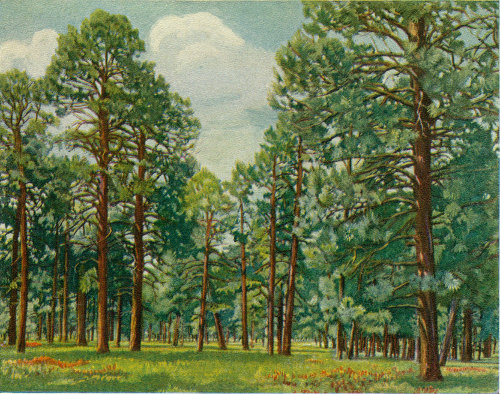
In the Kaibab National Forest
The Utah Parks Company maintains in Zion National Park, in a beautiful court beside the Mukuntuweap River at the foot of Red Arch Mountain and near the Great White Throne, one of the finest viewpoints in the Canyon, a handsome rustic Lodge Center and forty-six double guest lodges, accommodating 184 persons.
The Lodge Center is a two-story structure of native pine, with foundations and columns of rubble masonry. There is a broad verandah, a spacious lobby and lounging room, with a huge fireplace of rough stone, Navajo rugs, a radio set, retiring rooms and shower baths for men and women on the main floor. The attractive and commodious dining room, accommodating 100 guests, also with a fireplace, is on the second floor.
Each room in the cosy double lodges of native pine and fir is separate and private, although two may be used en suite by family parties. The rooms contain two single beds or one double bed, a stove, dressing table, chairs, rugs, and are lighted by two double windows. All of the furnishings are new and thoroughly comfortable and the service is thoughtful and courteous. The evening camp fire is a pleasing feature. Zion Lodge is a delightful place to linger.
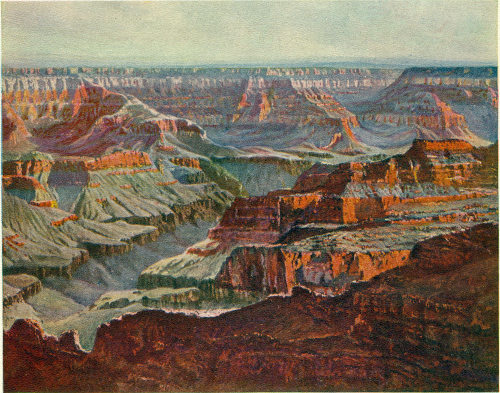
Sunset at North Rim, Grand Canyon
The visitor who merely rides in an automobile to Zion Lodge and goes no farther will obtain an entirely inadequate impression of its beauty.
There are two trips that none should miss. One is to the Narrows. An automobile road extends to the Temple of Sinawava, whence it is a walk of about two miles; or, horses may be ridden all the way from the Lodge, a distance of about six miles. The other trip is up the spectacular West Rim Trail either to the West Rim, with a nine-mile loop on the crest (an all-day trip) or to Angels Landing (a half-day trip); the West Rim Trail is perhaps one of the most scenic in the entire National Park System. There is also a trail up Cable Mountain to the East Rim, where splendid panoramas are unfolded. The trail up Lady Mountain, two miles in length, has 1,400 steps chiseled from the rock, two ladders and 2,000 feet of hand cable. A short walk east from the Lodge leads to a pretty waterfall and a rock-bound pool. Other interesting little excursions may be made and the guides will gladly give suggestions.
The Utah Parks Company maintains near the rim of Bryce Canyon an attractive rustic Lodge Center with a portico supported by massive logs. Bryce Lodge Center contains a hospitable lobby and lounge carpeted with Navajo rugs, and with a fireplace, a spacious dining room accommodating 100 guests, radio set, and retiring rooms and shower baths for men and women on the main floor.
In the pines adjacent to the Lodge Center are forty-six double guest lodges of native pine, accommodating 184 persons; each chamber is separate and private although they may be used en suite, if desired. Each room contains two single beds or one double bed, stove, dressing table, chairs, rugs and two double windows, all new, 38 comfortable and kept in spotless condition. Bryce Lodge is a short distance from the rim of the Canyon at one of its most enchanting viewpoints. There is a camp fire gathering each night.

Bright Angel Point, North Rim, Grand Canyon
On the North Rim of Grand Canyon, adjacent to Bright Angel Point, is the “Wylie” Bright Angel Camp consisting of a central dining tent and social room and comfortable tent cottages accommodating forty persons. Wholesome food is served and all of the camp accessories are spotlessly clean. “Wylie” Bright Angel Camp is under the management of Mrs. Elizabeth Wylie McKee.
V. T. Park Tourist Ranch, in DeMotte Park about eighteen miles north of Bright Angel Point, consists of a central dining pavilion seating ninety persons, and a recreation hall, ten log cabins and a dormitory accommodating seventy-five persons. Wholesome food and clean quarters may be had at V. T. Park Ranch, which is under the management of W. S. Rust.
Two weeks special vacation tours of Zion National Park, Cedar Breaks, Bryce Canyon National Monument and Colorado will leave Chicago every Saturday commencing June 20th and continuing through the season. These tours are at moderate cost, are escorted by a courteous, well-informed travel representative who relieves you of all the details by arranging for tickets, sleeping car and hotel reservations, automobile transportation, baggage transfers, sight-seeing guides, side-trips, etc., leaving you free to sit back, relax, and enjoy every minute of your vacation.
Similar tours are conducted to Yellowstone National Park and to California. Schedules permit each tour to be combined with any other; travelers may select a combination that appeals to individual inclination.
These tours are maintained by the Chicago & North Western Ry. and the Union Pacific System.
For complete information apply to
C. J. Collins, Manager
Department of Tours
148 South Clark St.
Chicago, Ill.
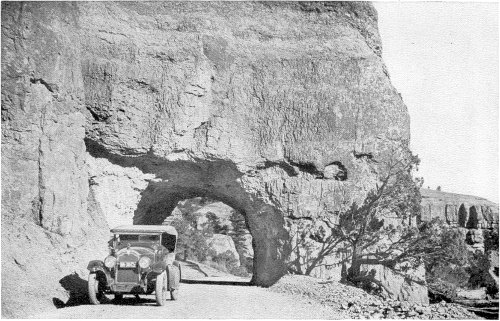
Red Canyon Highway, Southern Utah
THE 1926 SEASON
At Zion National Park, Bryce Canyon National Monument, Cedar Breaks, North Rim Grand Canyon and intermediate scenic regions is June 1 to October 1.
The schedules of motor bus tours shown herein are substantially correct except that improvement in road conditions has made possible in some instances faster schedules between points shown.
The 1926 edition of this booklet will be correct in all particulars.
The schedules and routes of the automobile tours shown herein are subject to such changes of operating convenience or necessity as may result from weather or road conditions.
(Note: The Union Pacific System shows herein the tours of the Utah & Grand Canyon Transportation Co. between Zion National Park and Grand Canyon, and between Bryce Canyon and Grand Canyon, merely as a matter of information, and does not assume any responsibility therefor. All other tours shown herein are operated by the Utah Parks Co., a subsidiary of the Union Pacific System.)
| 1st day— | Lv. Cedar City | 8.30 a.m. |
| ” | Ar. Zion National Park | 12.00 m. |
| 2d day— | Lv. Zion National Park | 2.30 p.m. |
| ” | Ar. Cedar City | 6.00 p.m. |
Automobile fare $15.00.
All-expense, including automobile transportation, four meals and one lodging in the Park, $21.25. From May 15 to June 10, and from Sept. 15 to Oct. 15, this tour will be operated only for a minimum of three full fares.
| 1st day— | Lv. Cedar City | 9.00 a.m. |
| ” | Ar. Cedar Breaks | 11.00 a.m. |
| ” | Lv. Cedar Breaks | 3.00 p.m. |
| ” | Ar. Cedar City | 5.30 p.m. |
Automobile fare, $7.50.
This tour will be operated only for a minimum of four full fares. Box lunch, price $1.00, will be carried from Cedar City.
| 1st day— | Lv. Cedar City | 8.30 a.m. |
| ” | Ar. Cedar Breaks | 10.30 a.m. |
| ” | Lv. Cedar Breaks | 1.00 p.m. |
| ” | Ar. Bryce Canyon | 4.30 p.m. |
| 2d day— | Lv. Bryce Canyon | 1.00 p.m. |
| ” | Ar. Cedar City | 6.30 p.m. |
Automobile fare, $20.00.
All-expense, including automobile transportation, box lunch at Cedar Breaks, three meals and lodging at Bryce Canyon, $26.00. From June 1 to June 10 and from Sept. 15 to Oct. 15, this tour will be operated only for a minimum of three full fares.
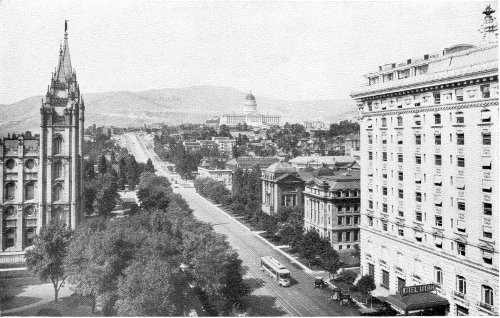
Salt Lake City, Utah, Showing Mormon Temple and State Capitol
Schedule of this tour is combination of No. 1 and No. 3. Automobile fare, $35.00. All-expense, including automobile transportation, four meals and one lodging at Zion Park, box lunch at Cedar Breaks, and three meals and one lodging at Bryce Canyon, $47.25. Expenses at Cedar City are not included. From June 1 to June 10, and from Sept. 15 to Oct. 15, this tour will be operated only for a minimum of three full fares.
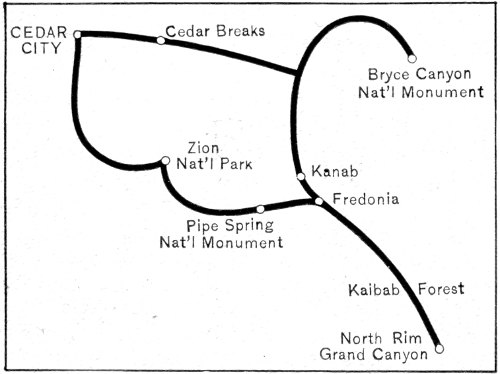
| 1st day— | Lv. Cedar City | 8.30 a.m. |
| ” | Ar. Zion National Park | 12.00 m. |
| 2d day— | Lv. Zion National Park | 8.00 a.m. |
| ” | Ar. Pipe Spring | 12.00 m. |
| ” | Lv. Pipe Spring | 1.00 p.m. |
| ” | Ar. Kaibab Forest | 6.00 p.m. |
| 3d day— | Lv. Kaibab Forest | 8.00 a.m. |
| ” | Ar. Grand Canyon | 9.00 a.m. |
| 4th day— | Lv. Grand Canyon | 8.00 a.m. |
| ” | Ar. Kanab | 12.00 m. |
| ” | Lv. Kanab | 1.00 p.m. |
| ” | Ar. Bryce Canyon | 6.00 p.m. |
| 5th day— | Lv. Bryce Canyon | 1.00 p.m. |
| ” | Ar. Cedar Breaks | 3.30 p.m. |
| ” | Lv. Cedar Breaks | 4.00 p.m. |
| ” | Ar. Cedar City | 6.30 p.m. |
Automobile fare, $65.00.
All-expense tour, including automobile transportation, three meals and one lodging at Zion National Park, box lunch at Pipe Spring, two meals and one lodging at V. T. Park in Kaibab Forest, three meals and one lodging at North Rim of Grand Canyon, lunch at Kanab and three meals and one lodging at Bryce Canyon, $86.75. From June 1 to June 10, and from Sept. 15 to Oct. 15, the portion of this tour between Cedar City and Zion National Park and Bryce Canyon will be operated only for a minimum of three full fares, and the portion from Zion National Park to Grand Canyon and return to Bryce Canyon, which will be operated by the Utah & Grand Canyon Transportation Co., only for a minimum of three full fares at any time.
| 1st day— | Lv. Cedar City | 8.30 a.m. |
| ” | Ar. Cedar Breaks | 10.30 a.m. |
| ” | Lv. Cedar Breaks | 1.00 p.m. |
| ” | Ar. Bryce Canyon | 4.30 p.m. |
| 2d day— | Lv. Bryce Canyon | 9.00 a.m. |
| ” | Ar. Kanab | 1.00 p.m. |
| ” | Lv. Kanab | 2.00 p.m. |
| ” | Ar. Kaibab Forest | 6.00 p.m. |
| 3d day— | Lv. Kaibab Forest | 8.00 a.m. |
| ” | Ar. Grand Canyon | 9.00 a.m. |
| 4th day— | Lv. Grand Canyon | 8.00 a.m. |
| ” | Ar. Fredonia | 12.00 m. |
| ” | Lv. Fredonia | 1.00 p.m. |
| ” | Ar. Zion National Park | 6.00 p.m. |
| 5th day— | Lv. Zion National Park | 2.30 p.m. |
| ” | Ar. Cedar City | 6.00 p.m. |
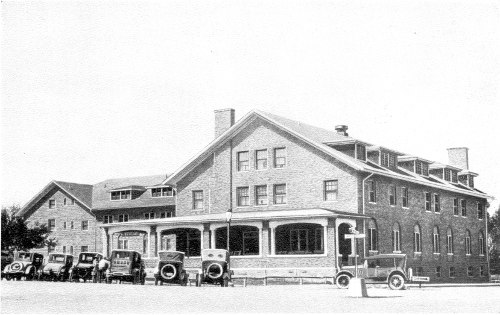
El Escalante Hotel, Cedar City, Utah
Automobile fare, $65.00.
All-expense tour, including automobile transportation, box lunch at Cedar Breaks, two meals and one lodging at Bryce Canyon, lunch at Kanab, two meals and one lodging at V. T. Park in Kaibab Forest, three meals and one lodging at North Rim of Grand Canyon, lunch at Fredonia, and three meals and one lodging at Zion National Park, $86.50. From June 1 to June 10, and from Sept. 15 to Oct. 15, the portion of this tour between Cedar City and Bryce Canyon and Zion National Park will be operated only for a minimum of three full fares, and the portion from Bryce Canyon to Grand Canyon and return to Zion National Park will be operated by the Utah & Grand Canyon Transportation Co. only for a minimum of three full fares at any time.
Note: As tour No. 6 is merely the reverse of tour No. 5, the diagram in connection with the latter will indicate also the outline of tour No. 6.
Persons desiring to make only the one-way trip between Cedar City and Grand Canyon, crossing from the North Rim to South Rim, or vice versa, may avail themselves of the portions of tours Nos. 5 and 6, as may be necessary, at following fares:
One way between Cedar City and Grand Canyon, via Zion National Park, $40.00. One way between Cedar City and Grand Canyon, via Bryce Canyon, $45.00. These tours will not be operated for less than three full fares.
As a matter of information, the trip across Grand Canyon requires two days and is made on horseback. The night is spent at Phantom Ranch, at the bottom of the Canyon and the Rim is reached the following afternoon. The cost, including horse, four meals, and one lodging is approximately $30.00 per person, guide extra.
Special automobiles (six passenger touring cars) may be chartered for any scheduled tour, for exclusive use, on basis of $25.00 per day, or part thereof, over and above the regular automobile per capita fare (see pages 39 and 40) for each person for tour availed of: the minimum for such special service will be 5 full fares plus the $25.00 per day or part thereof. If there are more than six persons in party, an eleven passenger type of car, if desired and if circumstances permit, will be furnished on the same per capita basis, plus $25.00 per day or part thereof.
The Union Pacific System maintains in many of the principal cities of the United States, also in Toronto, Ont., representatives who will gladly assist in making advance reservations at the lodges and camps. This service, and any information at the command of these representatives, is furnished, without charge, for the asking or writing. Their names and addresses are listed on Page 47.
From approximately May 15th to September 30th of each year, round-trip excursion tickets at very low fares are sold from various points in the United States and Canada to Cedar City, Utah, the rail terminus and the gateway to the scenic attractions in Southern Utah, also via Cedar City to Zion National Park, coupons 42 for latter being exchangeable for those covering any other of the tours shown on pages 39-40-41 upon payment of difference in fares; or coupons from Cedar City for any of the tours, including automobile transportation, and also, if desired, accommodations at the resort lodges, may be obtained at same price upon arrival at Cedar City.
Railroad tickets from eastern points when routed via the Union Pacific System are honored without extra charge via Denver, thus affording opportunity to visit Rocky Mountain National Park.
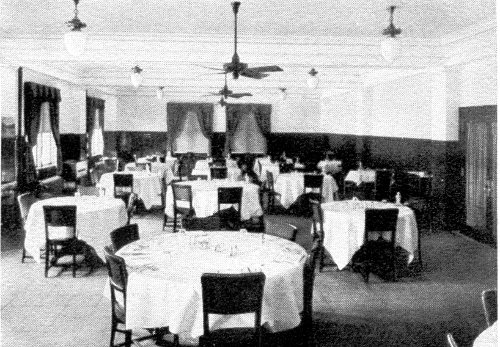
Dining Room, El Escalante Hotel
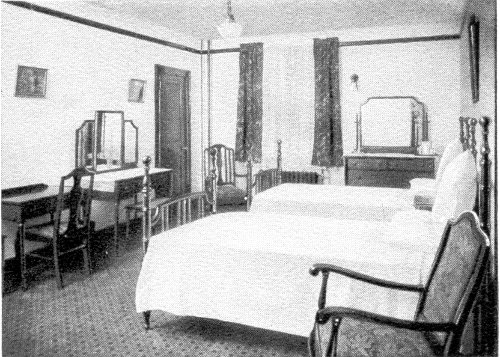
Bedroom, El Escalante Hotel
Holders of one-way or excursion tickets to Pacific Coast, or to Yellowstone Park, via the Union Pacific System, may obtain stopover at Salt Lake City, whence a low side-trip excursion fare is in effect during the season for Southern Utah visitors. Or if the through ticket is to or from Southern California via Union Pacific System, stopover may be made at Lund, Utah, whence there is also a low side-trip excursion fare to Cedar City, only thirty-two miles from Lund.
Baggage must not be checked beyond Cedar City. The automobiles of the Utah Parks Co. will carry not to exceed forty pounds of hand baggage free.
Storage charges will be waived on baggage left at Union Pacific System stations, Salt Lake City, Ogden, Lund, Cedar City, and Los Angeles, by passengers making any of the tours of the Utah Parks Co. from Cedar City.
Warm clothing should be worn and one should be prepared for the sudden changes of temperature common at elevations of from 8,000 to 9,000 feet. Medium weight overcoats, jackets or sweaters should be taken. Outing clothes, including riding breeches, stout shoes and puttees, or boots, and serviceable gloves will add to the comfort of men and women who wish to ride horseback, tramp or climb. Bring your camera. Field glasses are useful.
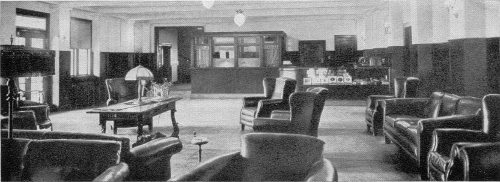
Lobby, El Escalante Hotel
CEDAR CITY—El Escalante Hotel, operated by the Union Pacific System, is a new, modern, commodious brick hotel, first class in all its appointments and service. Rates, without bath, $1.50 to $2.50 per day for one person, and $2.50 to $4.00 per day for two persons; with bath $3.00 to $4.00 per day for one person and $5.00 to $6.00 per day for two persons. Meals a la carte at reasonable rates.
ZION NATIONAL PARK—A handsome lodge operated by the Utah Parks Co. during the Park season affords comfortable accommodations at following rates: breakfast $1.00; lunch $1.25; dinner $1.50; lodging $1.75. American plan rate per day $5.50.
BRYCE CANYON—The attractive, comfortable lodge situated near the rim of the Canyon is operated by the Utah Parks Co.: breakfast $1.00; lunch $1.25; dinner $1.50; lodging $1.75. American plan rate per day $5.50.
GRAND CANYON (NORTH RIM)—Bright Angel “Wylie” Camp (operated by Mrs. Elizabeth McKee), 43 situated near Bright Angel Point within the boundaries of the Grand Canyon National Park, has the following rates: breakfast $1.50; lunch $1.50; dinner $1.50; lodging $1.50. American plan rate per day $6.00.
V. T. PARK—A camp in the Kaibab National Forest (operated by W. S. Rust), en route to, and about eighteen miles from, Bright Angel Point, Grand Canyon, is known as the V. T. Park Tourist Ranch: breakfast $1.00; lunch $1.25; dinner $1.25; lodging $1.50. American plan rate per day $5.00.
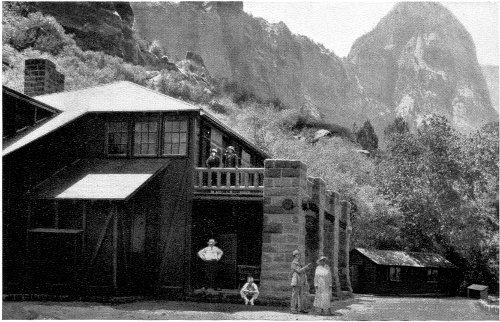
Zion Lodge Center, Zion National Park
Saddle horses and competent guides are available for all of the interesting trail trips at reasonable rates approved by the United States National Park Service.
| Rates per Person per Hour (or Fraction) | ||
| Without Guide | With Mounted Guide | |
| One Person | $1.00 | $3.00 |
| Two Persons | 1.00 | 1.50 |
| Three Persons | 1.00 | 1.00 |
| Rates per Person per Half Day, 4 Hours | ||
| One Person | $2.50 | $7.50 |
| Two Persons | 2.50 | 3.75 |
| Three Persons | 2.50 | 2.50 |
| Rates per Person per Day, 8 Hours | ||
| One Person | $3.50 | $8.50 |
| Two Persons | 3.50 | 5.25 |
| Three Persons | 3.50 | 3.50 |
| Rates per Person per Day (8 Hours) with Mounted Guide | |
| One Person | $10.00 |
| Two Persons | 7.50 |
| Three Persons | 5.00 |
A half-day (4 hours) trip, with mounted guide, into Bryce Canyon is also available at following rates: one person, $9.00; two persons, $4.50 each; three or more persons, $3.00 each.
Saddle horses and guides are also available at V. T. Park Tourist Ranch in Kaibab Forest, and at Bright Angel “Wylie” Camp, North Rim of Grand Canyon, at reasonable rates approved by the Forest Service and the National Park Service, respectively.
| Feet | |
| Cedar City | 5,750 |
| Rim of Great Basin | 5,500 |
| Pine Valley Mountains | 10,250 |
| Toquerville | 3,100 |
| Floor of Zion Canyon | 4,100 |
| Summit of West Temple | 7,650 |
| Cedar Breaks (Rim) | 10,300 |
| Brian Head | 11,300 |
| Navajo Lake | 9,500 |
| Cedar Breaks Junction | 7,000 |
| Bryce Canyon (Rim) | 8,000 |
| Pipe Spring | 5,000 |
| Fredonia | 4,700 |
| V. T. Park Tourist Ranch | 8,700 |
| Bright Angel Camp (North Rim, Grand Canyon) | 8,300 |
| Bright Angel Point (North Rim, Grand Canyon) | 8,153 |
| Point Imperial (North Rim, Grand Canyon) | 9,000 |
| Cape Royal (North Rim, Grand Canyon) | 7,876 |
| Cape Final (North Rim, Grand Canyon) | 7,919 |
| Point Sublime (North Rim, Grand Canyon) | 7,464 |
| Kanab | 4,925 |
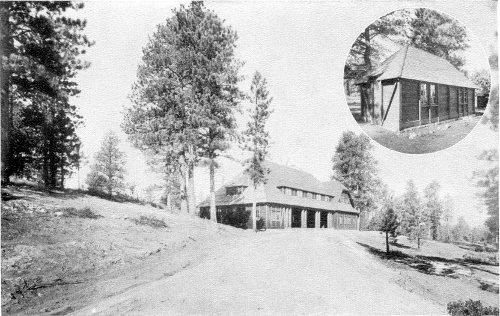
Lodge Center at Bryce Canyon and (Inset) Typical Guest Lodge
| Miles | |
| Salt Lake City, Utah, to Cedar City, Utah | 275 |
| Los Angeles, Calif., to Cedar City, Utah | 574 |
| Lund, Utah, to Cedar City, Utah | 32.5 |
| Cedar City to Toquerville | 36.2 |
| Cedar City to Zion National Park (Entrance) | 62.1 |
| Cedar City to Zion Lodge | 64.8 |
| Cedar City to Midway | 19.9 |
| Cedar City to Cedar Breaks Jctn | 45 |
| Cedar City to Cedar Breaks | 23 |
| Cedar City to Bryce Canyon National Monument | 89 |
| Cedar City to Pipe Spring National Monument | 94.6 |
| Cedar City to Fredonia | 109.7 |
| Cedar City to V. T. Park Tourist Ranch | 165 |
| Cedar City to Bright Angel Point (North Rim, Grand Canyon National Park, via Zion National Park) | 200.8 |
| Zion National Park to Pipe Spring | 45 |
| Zion National Park to Fredonia | 60 |
| Zion National Park to Bright Angel Point (North Rim, Grand Canyon National Park) | 136 |
| Cedar Breaks to Midway | 3.1 |
| Cedar Breaks to Navajo Lake | 10.1 |
| Cedar Breaks to Cedar Breaks Junction | 28 |
| Cedar Breaks to Red Canyon | 56 |
| Cedar Breaks to Bryce Canyon National Monument | 70 |
| Bright Angel Point (North Rim, Grand Canyon) to V. T. Park Tourist Ranch | 18 |
| Bright Angel Point to Fredonia | 75.6 |
| Bright Angel Point to Kanab | 82.4 |
| Bright Angel Point Cedar Breaks Jctn | 123 |
| Bright Angel Point to Bryce Canyon National Monument | 164.2 |
| Zion Lodge to Great White Throne | 2 |
| Zion Lodge to The Narrows | 6 |
| Zion Lodge to Summit of Angels Landing | 2.5 |
| Zion Lodge to Observation Point | 12 |
| Zion Lodge to West Rim | 12 |
| Zion Lodge to Ranger Station | 5 |
| Zion Lodge to Summit of Lady Mountain | 2 |
| Bryce Canyon Lodge to floor of Canyon and return | 1 |
| Bryce Canyon Lodge to Tropic | 11 |
| Bright Angel Camp to Bright Angel Point | .5 |
| Bright Angel Camp to Point Imperial | 9 |
| Bright Angel Camp to Cape Final | 12 |
| Bright Angel Camp to Cliff Spring | 15 |
| Bright Angel Camp to Cape Royal | 16 |
| Bright Angel Camp to Cliff Dweller Spring | 1 |
| Bright Angel Camp to Point Sublime | 35 |
| V. T. Park Tourist Ranch to Point Imperial | 22 |
| V. T. Park Tourist Ranch to Cape Final | 25 |
| V. T. Park Tourist Ranch to Point Sublime | 23 |
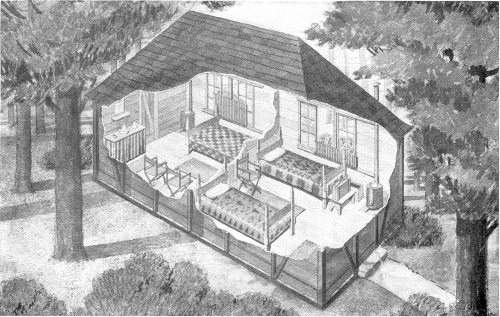
Interior of Guest Lodge, Zion National Park and Bryce Canyon
Rearranged and visualized principally from unpublished studies of Willis T. Lee, by courtesy of the National Parks Association.
These strata presumably were once continuous over the entire Plateau Region and the Grand Canyon. Many were much thicker than now, having been eroded during long periods when the surface was temporarily lifted above sea level. Altogether they may cover a creative period exceeding ninety million years. Strata are said to be unconformable when they do not lie in regular, parallel sequence.
Read table from bottom upward for historical sequence.
Cedar Breaks, some 2,000 feet higher than Bryce Canyon, is eroded from similar formation to that at Bryce Canyon.
| FORMATION | PRESENT DEPTH (Feet) | GEOLOGICAL AGE | DESCRIPTION | |
|---|---|---|---|---|
| Basalt | Bryce | Sheets of very dark lava, resting unconformably upon the Pink Cliff below. | ||
| Pink Cliff | 500 | Eocene | Richly colored shales, limestones and conglomerates, most of them red, and containing fossils. | |
| Cretaceous Rocks | 3000 | Upper Cretaceous | Gray to buff sandstone and drab shales, alternating with occasional coal beds. | |
| McElmo Formation | 800 | Lower Cretaceous | Shales and sandstones of many colors. | |
| Jurassic Rocks | 600 | Jurassic | Drab shale, chocolate colored limestone and occasional gray gypsum beds. | |
| White Cliff | 1000 | Jurassic | Zion | White, cross-bedded sandstone. Modern geology considers the White and Vermilion Cliffs part of the same formation, but scenically they will always be distinguished. |
| Vermilion Cliff | 2000 | Jurassic | Brilliant red, variegated, massive sandstone. | |
| Chinle Formation | 350 | Late Triassic | Mauve sandstone above, purple and red shale below. | |
| Shinarump Conglomerate | 100 | Late Triassic | Brown, yellow and gray conglomerate and sandstone, celebrated for its petrified trees. | |
| Moenkopi Formation | 1600 | Early Triassic | Purple, yellowish-gray, dull red and coffee-brown sandstones, in a great body of rich red shale. Contains a few layers of hard red, brown and gray limestone and some light-colored gypsum beds. Known also as the Belted Shales. | |
| Kaibab Limestone | 1800 | Late Carboniferous | The same gray, massive limestone seen on the Rim of the Grand Canyon. The road from Cedar City to Zion Canyon runs over it for several miles. |
| Kaibab Limestone | 800 | Late Carboniferous | Grand Canyon | Gray limestone formed in the sea, as indicated by many Carboniferous fossil shells. At the Grand Canyon it is the surface rock. In the Plateau Country to the north, it lies at the bottom of the series. |
| Coconino | 300 | Carboniferous | Very massive, cross-bedded yellow sandstone. | |
| Supai Formation | 1100 | Carboniferous | Alternating red shale and red and brown sandstone, the latter forming low cliffs. This constitutes the greatest red body of the Canyon wall. | |
| Redwall Limestone | 600 | Carboniferous | Extremely hard blue or gray limestone, forming the greatest cliff of the Grand Canyon. It is stained a vivid red by the wash of the red Supai shales above. The cliff is a conspicuous feature of the Canyon everywhere. | |
| Missing Strata | Devonian Silurian Ordovician | During Devonian, Silurian and Ordovician times, extensive strata were deposited upon the Cambrian rocks below, but were wholly eroded away during a long uplift period and the limestone known as the Red Wall was deposited on the Tonto during a succeeding period. | ||
| Tonto Group | 950 | Cambrian | Olive green shale and limestone, forming the broad green floor of the Grand Canyon, through which winds the Granite Gorge. | |
| Unkar and Chuar Groups known as the Grand Canyon Series | Algonkian | Greenish sandstones, fine quartzites and vividly red shales, once 13,000 feet thick, but here eroded away till they appear only in places. | ||
| Granite Gorge | 1200 | Archean | Schists metamorphosed from sedentary rocks, and intruded igneous rocks. |
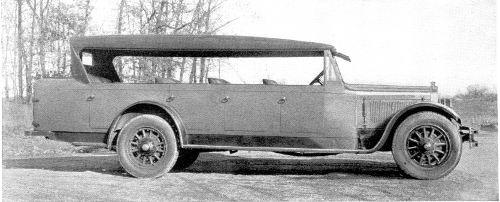
Utah Parks Co. Automobile Specially Designed for Southern Utah Travel
| Aberdeen, Wash. | 3-4 Union Pass’r Sta., K and River Streets | F. E. STUDEBAKER, Dist. Freight and Passenger Agent |
| Astoria, Ore. | Union Pacific System Wharf | G. W. ROBERTS, District Freight and Passenger Agent |
| Atlanta, Ga. | 1232 Healey Building | W. C. ELGIN, General Agent |
| Bend, Ore. | E. H. McALLEN, Traveling Freight and Passenger Agent | |
| Birmingham, Ala. | 742 Brown-Marx Building, First Avenue and Twentieth Street | J. H. DOUGHTY, General Agent |
| Boise, Idaho | 823 Idaho Street | JOEL L. PRIEST, General Agent |
| Boston, Mass. | 207-8 Old South Building, 204 Washington Street | WILLARD MASSEY, General Agent |
| Butte, Mont. | 229 Rialto Building, 4 South Main Street | HENRY COULAM, General Agent |
| Cheyenne, Wyo. | Union Pacific Station | O. B. STAPLETON, Ticket Agent |
| Chicago, Ill. | 1421 Garland Building, 58 E. Washington Street | G. R. LEMMER, General Agent, Pass’r Department |
| Cincinnati, Ohio | 704 Union Central Building, Fourth and Vine Streets | W. H. CONNOR, General Agent |
| J. STANLEY ORR, District Passenger Agent | ||
| Cleveland, Ohio | 941 Union Trust Building, 925 Euclid Avenue | W. H. BENHAM, General Agent |
| Council Bluffs, Ia. | City Ticket Office, 37 Pearl Street | H. B. ELLER, City Ticket Agent |
| Dallas, Texas | 909 Magnolia Building, Commerce and Akard Streets | JULIAN NANCE, General Agent |
| Denver, Colo. | 601 Seventeenth Street | W. K. CUNDIFF, Assistant General Passenger Agent |
| Des Moines, Ia. | 407 Equitable Building, Sixth and Locust Streets | D. M. SHRENK, General Agent |
| Detroit, Mich. | 508 Transportation Building, 131 Lafayette Boulevard, West | A. R. MALCOLM, General Agent |
| Fort Collins, Colo. | Union Pacific Station | L. B. WHITEHEAD, Passenger and Ticket Agent |
| Fresno, Calif. | 207-8 Rowell Building, Tulare Street and Van Ness Avenue | T. F. BROSNAHAN, General Agent |
| Glendale, Calif. | 129 South Brand Boulevard | C. A. REDMOND, City Passenger Agent |
| Hollywood, Calif. | City Ticket Office, Christie Hotel, 6732 Hollywood Blvd. | W. L. RAMBO, City Pass’r and Tkt. Agent |
| Kansas City, Mo. | 805 Walnut Street | SETH C. RHODES, General Agent, Passenger Department |
| Leavenworth, Kan. | Union Station, Main and Delaware Streets | A. E. MARTENY, General Agent |
| Lewiston, Idaho | 224 Breier Building | H. J. BERGER, Traveling Freight and Passenger Agent |
| Lincoln, Neb. | City Ticket Office, 204 North Eleventh Street | A. D. GRANT, General Agent |
| Long Beach, Calif. | 120 West Ocean Boulevard | R. W. SMOCK, General Agent |
| Los Angeles, Calif. | 221 South Broadway | J. CRUICKSHANK, General Agent, Passenger Department |
| A. T. JACKSON, District Passenger Agent | ||
| Milwaukee, Wis. | 1205 Majestic Building, 221 Grand Avenue | E. G. CLAY, General Agent |
| Minneapolis, Minn. | 618 Metropolitan Life Building, 125 South Third Street | E. H. HAWLEY, General Agent |
| New Orleans, La. | 1001 Carondelet Building, 220 Carondelet Street | R. A. PETERS, General Agent |
| New York, N. Y. | 309-10 Stewart Building, 280 Broadway | J. B. DePRIEST, General Agent |
| I. W. CARTER, District Passenger Agent | ||
| Oakland, Calif. | 409 Henshaw Building, 433 Fourteenth Street | JAMES WARRACK, General Agent |
| Ocean Park, Calif. | 149 Pier Avenue | S. C. FROST, District Freight and Passenger Agent |
| Ogden, Utah | 214 David Eccles Building, 390 Twenty-Fourth Street | W. H. CHEVERS, General Agent |
| Omaha, Neb. | 1523 Farnam Street | L. BEINDORFF, General Agent, Passenger Department |
| Pasadena, Calif. | 395 East Colorado Street | F. H. ADAMS, General Agent |
| Philadelphia, Pa. | 508 Commercial Trust Building, 15th and Market Streets | F. L. FEAKINS, General Agent |
| Pittsburgh, Pa. | 216 Oliver Building, Smithfield Street and Sixth Avenue | JOHN D. CARTER, General Agent |
| EDWARD EMERY, District Passenger Agent | ||
| Portland, Ore. | 628-37 Pittock Block, 385½ Washington Street | L. E. OMER, City Passenger Agent |
| Redlands, Calif. | 14 Cajon Street | W. H. PETTIBONE, City Freight and Passenger Agent |
| Reno, Nev. | 200 Nevada State Life Building. Second and Center Streets | F. D. WILSON, General Agent |
| Riverside, Calif. | Glenwood Mission Inn, 680 Main Street | F. E. MIDDLETON, General Agent |
| Sacramento, Calif. | 221 California Fruit Building, 1006 Fourth Street | C. T. SLAUSON, General Agent |
| St. Joseph, Mo. | 302 Bartlett Trust Building, Frederick Avenue and Felix Street | S. E. STOHR, General Freight and Passenger Agent, St. J. & G. I. Ry. Co. |
| St. Louis, Mo. | 2053 Railway Exchange Building, 611 Olive Street | J. L. CARNEY, General Agent |
| Salt Lake City, Utah | City Ticket Office, Hotel Utah, Main and South Temple Sts. | E. A. SHEWE, District Passenger Agent |
| San Diego, Calif. | Fourth and Plaza Streets | C. C. JEWETT, General Agent |
| San Francisco, Calif. | City Ticket Office, 673 Market Street | H. A. BUCK, District Passenger Agent |
| San Pedro, Calif. | 101 West 7th Street | J. V. CARROLL, District Freight and Passenger Agent |
| Santa Ana, Calif. | 305 N. Main St. | C. S. BROWNE, General Agent |
| Seattle, Wash. | 201 Union Station, 4th Ave. and Jackson St. | W. H. OLIN, Ass’t General Freight and Passenger Agent |
| City Ticket Office, 1405 Fourth Avenue | H. A. LAWRENCE, General Agent, Passenger Department | |
| Spokane, Wash. | 727 Sprague Avenue | F. H. HOCKEN, District Freight and Passenger Agent |
| Tacoma, Wash. | 106 South Tenth Street | WM. CARRUTHERS. District Freight and Passenger Agent |
| Toronto, Ontario | 201 Canadian Pacific Building, 69 Yonge Street | GEO. W. VAUX, General Agent |
| Walla Walla, Wash. | Baker Building, Main and Second Streets | W. J. LEONARD, District Freight and Passenger Agent |
| Whittier, Calif. | Union Pacific System Passenger Station | G. B. KENNARD, City Freight and Passenger Agent |
| Yakima, Wash. | Union Pacific Bldg., 104 West Yakima Avenue | H. M. WEST, District Freight and Passenger Agent |
DEPARTMENT OF TOURS
(C. & N. W. Ry.—Union Pacific System)
C. J. COLLINS, Manager
148 S. Clark St., Chicago, Ill.
W. H. MURRAY
General Passenger Agent
OMAHA, NEB.
D. S. SPENCER
General Passenger Agent
SALT LAKE CITY, UTAH
WM. McMURRAY
General Passenger Agent
PORTLAND, ORE.
T. C. PECK
General Passenger Agent
LOS ANGELES, CALIF.
JOHN L. AMOS
Assistant Traffic Manager
Deseret News Bldg.
SALT LAKE CITY, UTAH
A. S. EDMONDS
Assistant Traffic Manager
PORTLAND, ORE.
.............
Assistant Traffic Manager
LOS ANGELES, CALIF.
A. V. KIPP
Assistant Traffic Manager
415 Monadnock Bldg., 681 Market St.
SAN FRANCISCO, CALIF.
W. S. BASINGER
Passenger Traffic Manager
OMAHA, NEB.